Business and Business Environment Analysis
VerifiedAdded on 2024/04/26
|25
|4638
|445
AI Summary
This analysis delves into the types of organizations, their structures, and the impact of macro and micro environmental factors on business operations. It explores the interrelationships between organizational functions and decision-making processes.
Contribute Materials
Your contribution can guide someone’s learning journey. Share your
documents today.
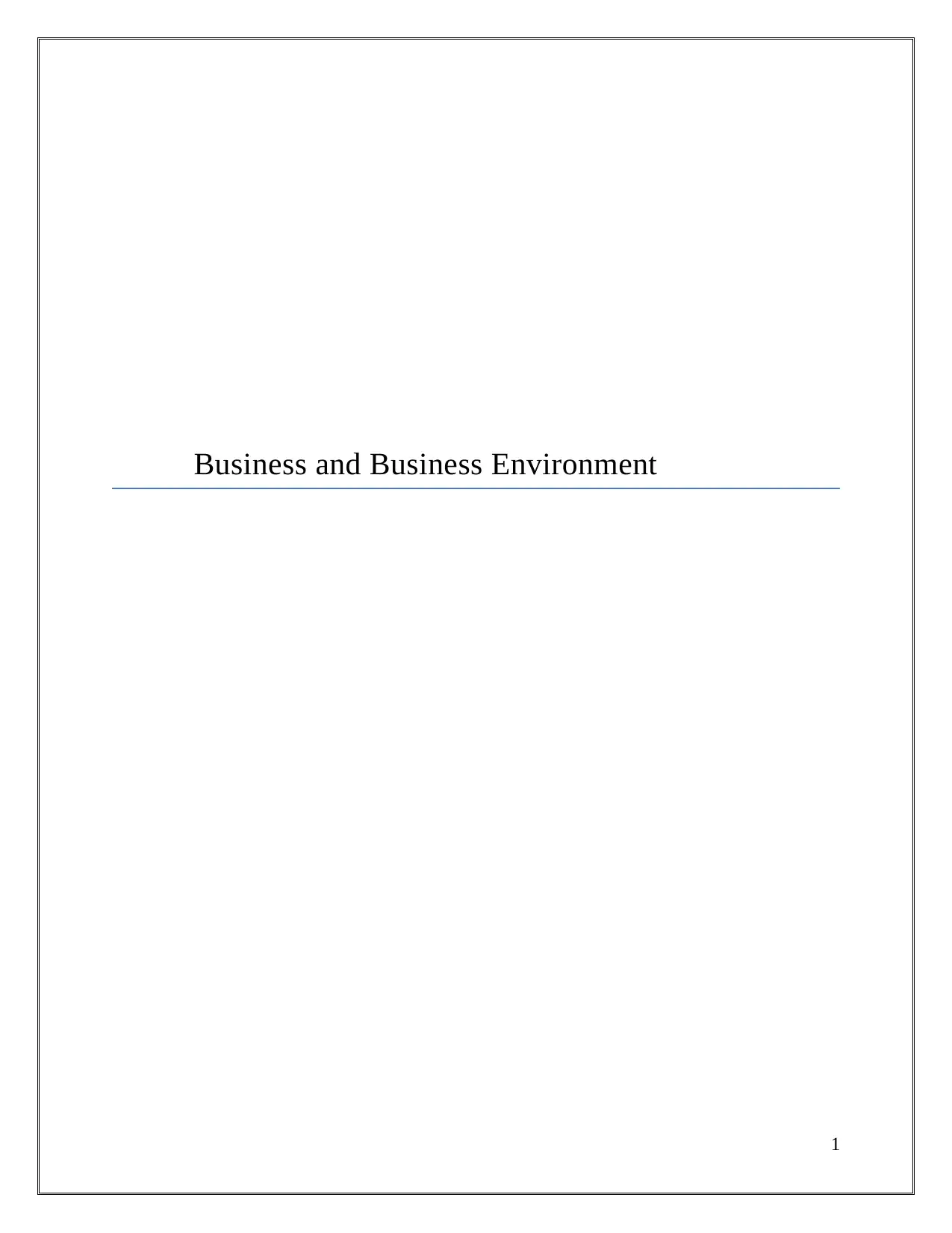
Business and Business Environment
1
1
Secure Best Marks with AI Grader
Need help grading? Try our AI Grader for instant feedback on your assignments.
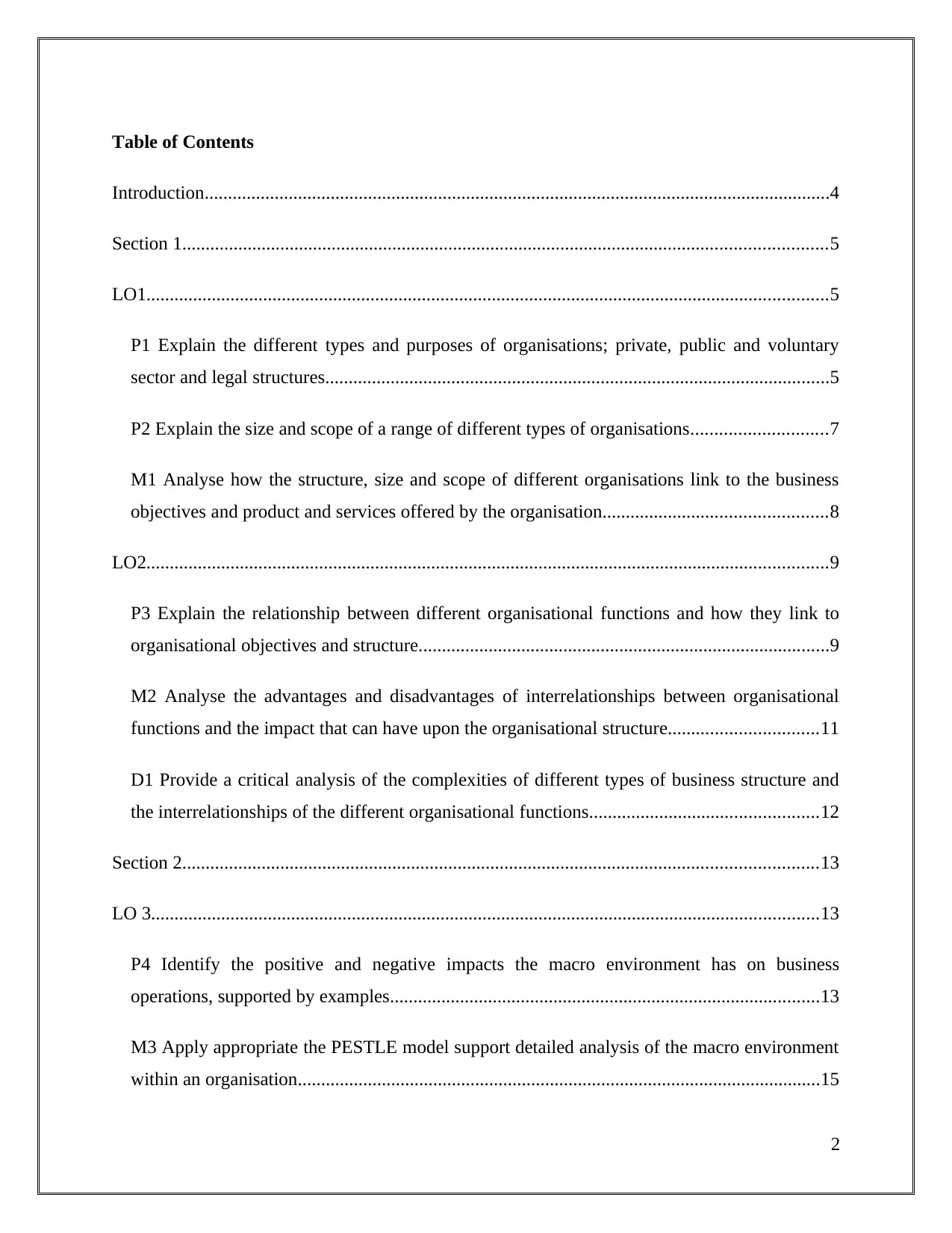
Table of Contents
Introduction......................................................................................................................................4
Section 1..........................................................................................................................................5
LO1..................................................................................................................................................5
P1 Explain the different types and purposes of organisations; private, public and voluntary
sector and legal structures............................................................................................................5
P2 Explain the size and scope of a range of different types of organisations.............................7
M1 Analyse how the structure, size and scope of different organisations link to the business
objectives and product and services offered by the organisation................................................8
LO2..................................................................................................................................................9
P3 Explain the relationship between different organisational functions and how they link to
organisational objectives and structure........................................................................................9
M2 Analyse the advantages and disadvantages of interrelationships between organisational
functions and the impact that can have upon the organisational structure................................11
D1 Provide a critical analysis of the complexities of different types of business structure and
the interrelationships of the different organisational functions.................................................12
Section 2........................................................................................................................................13
LO 3...............................................................................................................................................13
P4 Identify the positive and negative impacts the macro environment has on business
operations, supported by examples............................................................................................13
M3 Apply appropriate the PESTLE model support detailed analysis of the macro environment
within an organisation................................................................................................................15
2
Introduction......................................................................................................................................4
Section 1..........................................................................................................................................5
LO1..................................................................................................................................................5
P1 Explain the different types and purposes of organisations; private, public and voluntary
sector and legal structures............................................................................................................5
P2 Explain the size and scope of a range of different types of organisations.............................7
M1 Analyse how the structure, size and scope of different organisations link to the business
objectives and product and services offered by the organisation................................................8
LO2..................................................................................................................................................9
P3 Explain the relationship between different organisational functions and how they link to
organisational objectives and structure........................................................................................9
M2 Analyse the advantages and disadvantages of interrelationships between organisational
functions and the impact that can have upon the organisational structure................................11
D1 Provide a critical analysis of the complexities of different types of business structure and
the interrelationships of the different organisational functions.................................................12
Section 2........................................................................................................................................13
LO 3...............................................................................................................................................13
P4 Identify the positive and negative impacts the macro environment has on business
operations, supported by examples............................................................................................13
M3 Apply appropriate the PESTLE model support detailed analysis of the macro environment
within an organisation................................................................................................................15
2
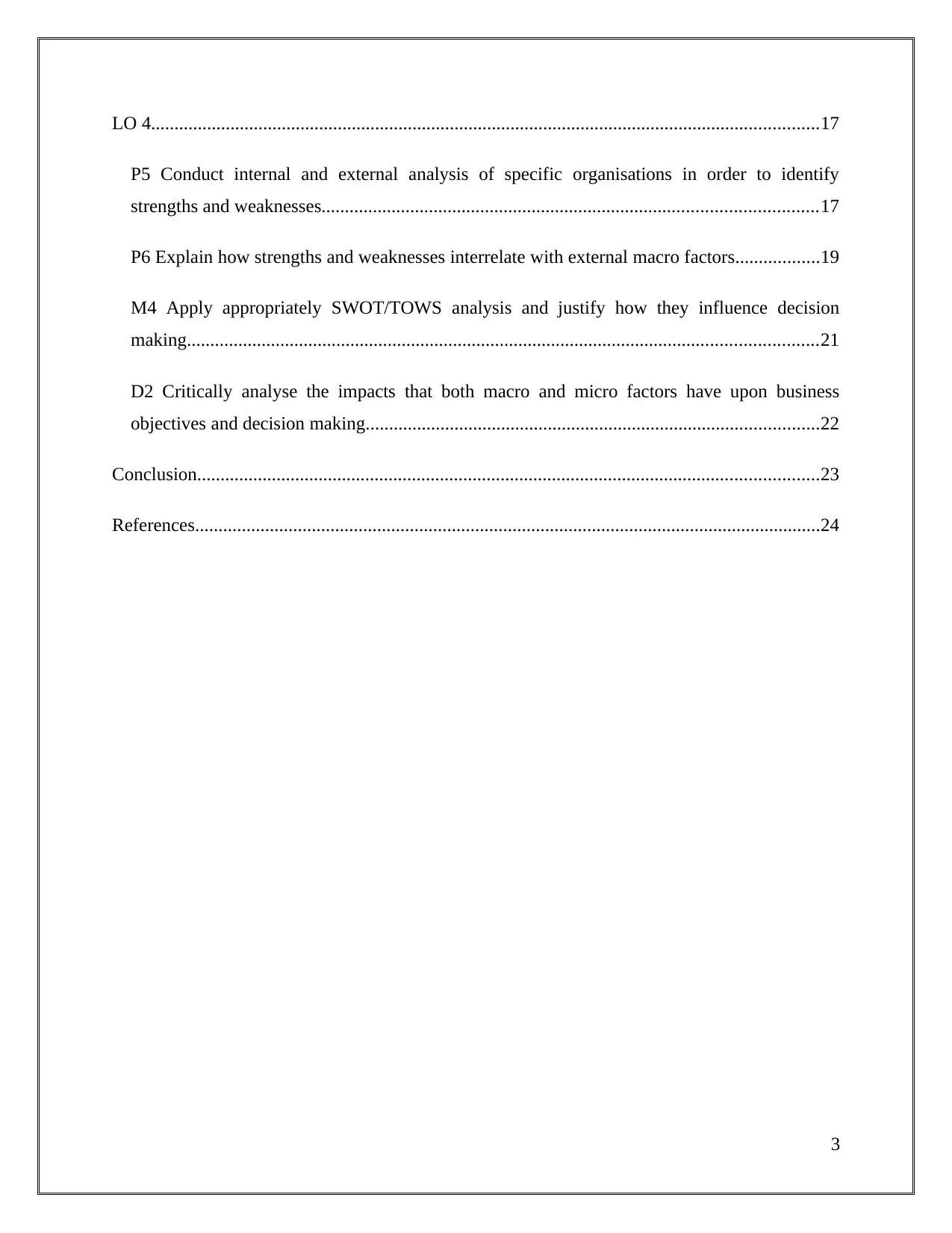
LO 4...............................................................................................................................................17
P5 Conduct internal and external analysis of specific organisations in order to identify
strengths and weaknesses..........................................................................................................17
P6 Explain how strengths and weaknesses interrelate with external macro factors..................19
M4 Apply appropriately SWOT/TOWS analysis and justify how they influence decision
making.......................................................................................................................................21
D2 Critically analyse the impacts that both macro and micro factors have upon business
objectives and decision making.................................................................................................22
Conclusion.....................................................................................................................................23
References......................................................................................................................................24
3
P5 Conduct internal and external analysis of specific organisations in order to identify
strengths and weaknesses..........................................................................................................17
P6 Explain how strengths and weaknesses interrelate with external macro factors..................19
M4 Apply appropriately SWOT/TOWS analysis and justify how they influence decision
making.......................................................................................................................................21
D2 Critically analyse the impacts that both macro and micro factors have upon business
objectives and decision making.................................................................................................22
Conclusion.....................................................................................................................................23
References......................................................................................................................................24
3
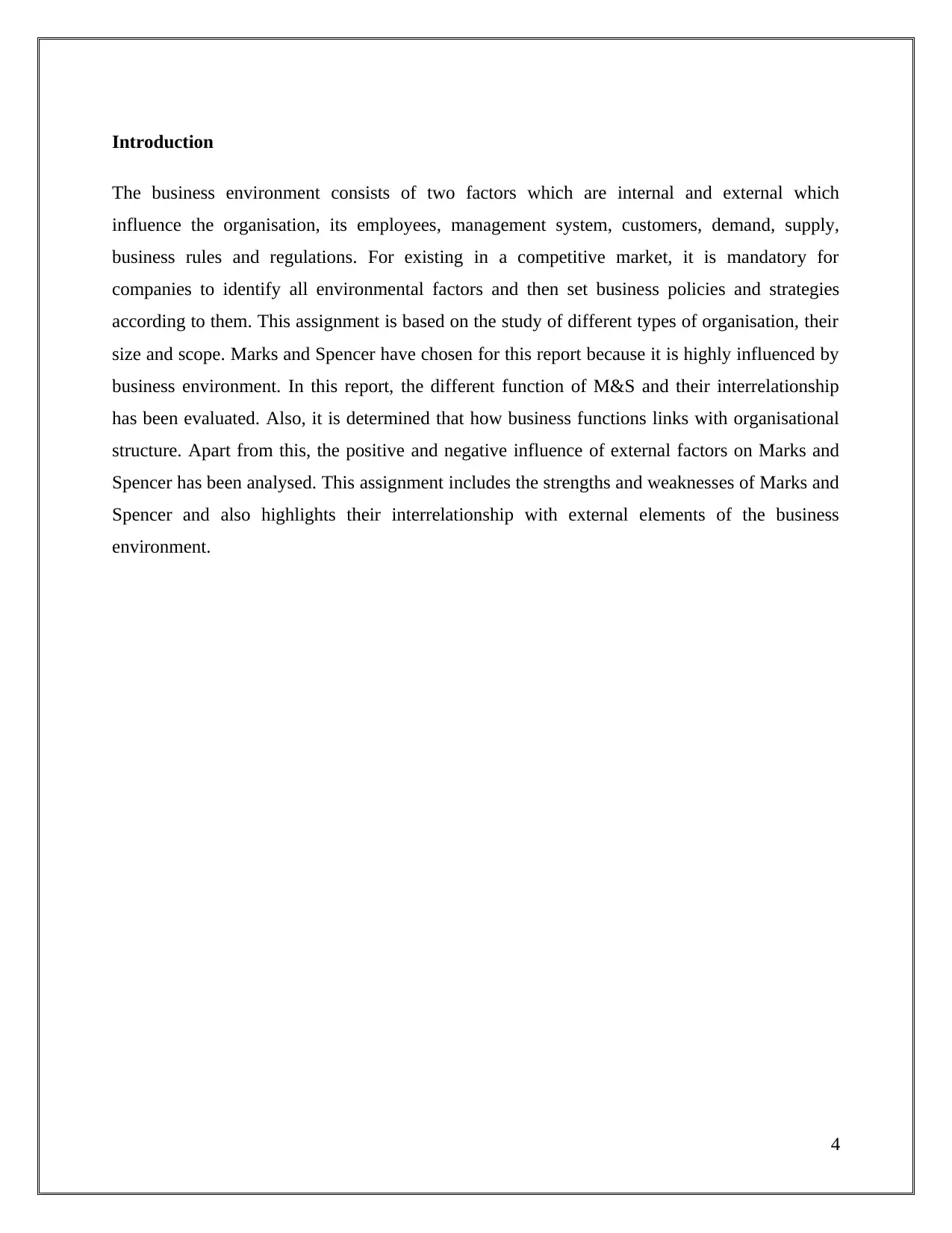
Introduction
The business environment consists of two factors which are internal and external which
influence the organisation, its employees, management system, customers, demand, supply,
business rules and regulations. For existing in a competitive market, it is mandatory for
companies to identify all environmental factors and then set business policies and strategies
according to them. This assignment is based on the study of different types of organisation, their
size and scope. Marks and Spencer have chosen for this report because it is highly influenced by
business environment. In this report, the different function of M&S and their interrelationship
has been evaluated. Also, it is determined that how business functions links with organisational
structure. Apart from this, the positive and negative influence of external factors on Marks and
Spencer has been analysed. This assignment includes the strengths and weaknesses of Marks and
Spencer and also highlights their interrelationship with external elements of the business
environment.
4
The business environment consists of two factors which are internal and external which
influence the organisation, its employees, management system, customers, demand, supply,
business rules and regulations. For existing in a competitive market, it is mandatory for
companies to identify all environmental factors and then set business policies and strategies
according to them. This assignment is based on the study of different types of organisation, their
size and scope. Marks and Spencer have chosen for this report because it is highly influenced by
business environment. In this report, the different function of M&S and their interrelationship
has been evaluated. Also, it is determined that how business functions links with organisational
structure. Apart from this, the positive and negative influence of external factors on Marks and
Spencer has been analysed. This assignment includes the strengths and weaknesses of Marks and
Spencer and also highlights their interrelationship with external elements of the business
environment.
4
Secure Best Marks with AI Grader
Need help grading? Try our AI Grader for instant feedback on your assignments.
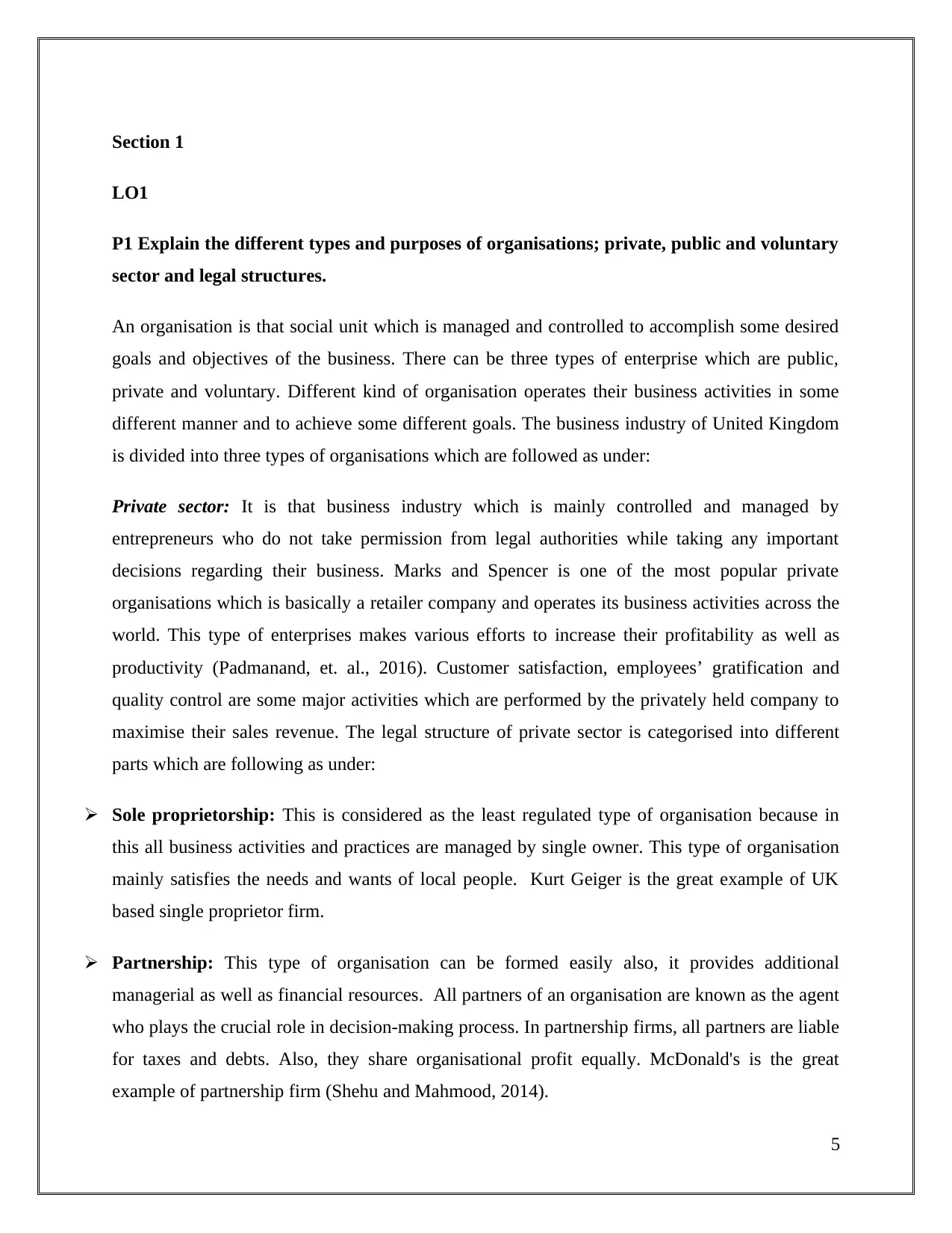
Section 1
LO1
P1 Explain the different types and purposes of organisations; private, public and voluntary
sector and legal structures.
An organisation is that social unit which is managed and controlled to accomplish some desired
goals and objectives of the business. There can be three types of enterprise which are public,
private and voluntary. Different kind of organisation operates their business activities in some
different manner and to achieve some different goals. The business industry of United Kingdom
is divided into three types of organisations which are followed as under:
Private sector: It is that business industry which is mainly controlled and managed by
entrepreneurs who do not take permission from legal authorities while taking any important
decisions regarding their business. Marks and Spencer is one of the most popular private
organisations which is basically a retailer company and operates its business activities across the
world. This type of enterprises makes various efforts to increase their profitability as well as
productivity (Padmanand, et. al., 2016). Customer satisfaction, employees’ gratification and
quality control are some major activities which are performed by the privately held company to
maximise their sales revenue. The legal structure of private sector is categorised into different
parts which are following as under:
Sole proprietorship: This is considered as the least regulated type of organisation because in
this all business activities and practices are managed by single owner. This type of organisation
mainly satisfies the needs and wants of local people. Kurt Geiger is the great example of UK
based single proprietor firm.
Partnership: This type of organisation can be formed easily also, it provides additional
managerial as well as financial resources. All partners of an organisation are known as the agent
who plays the crucial role in decision-making process. In partnership firms, all partners are liable
for taxes and debts. Also, they share organisational profit equally. McDonald's is the great
example of partnership firm (Shehu and Mahmood, 2014).
5
LO1
P1 Explain the different types and purposes of organisations; private, public and voluntary
sector and legal structures.
An organisation is that social unit which is managed and controlled to accomplish some desired
goals and objectives of the business. There can be three types of enterprise which are public,
private and voluntary. Different kind of organisation operates their business activities in some
different manner and to achieve some different goals. The business industry of United Kingdom
is divided into three types of organisations which are followed as under:
Private sector: It is that business industry which is mainly controlled and managed by
entrepreneurs who do not take permission from legal authorities while taking any important
decisions regarding their business. Marks and Spencer is one of the most popular private
organisations which is basically a retailer company and operates its business activities across the
world. This type of enterprises makes various efforts to increase their profitability as well as
productivity (Padmanand, et. al., 2016). Customer satisfaction, employees’ gratification and
quality control are some major activities which are performed by the privately held company to
maximise their sales revenue. The legal structure of private sector is categorised into different
parts which are following as under:
Sole proprietorship: This is considered as the least regulated type of organisation because in
this all business activities and practices are managed by single owner. This type of organisation
mainly satisfies the needs and wants of local people. Kurt Geiger is the great example of UK
based single proprietor firm.
Partnership: This type of organisation can be formed easily also, it provides additional
managerial as well as financial resources. All partners of an organisation are known as the agent
who plays the crucial role in decision-making process. In partnership firms, all partners are liable
for taxes and debts. Also, they share organisational profit equally. McDonald's is the great
example of partnership firm (Shehu and Mahmood, 2014).
5
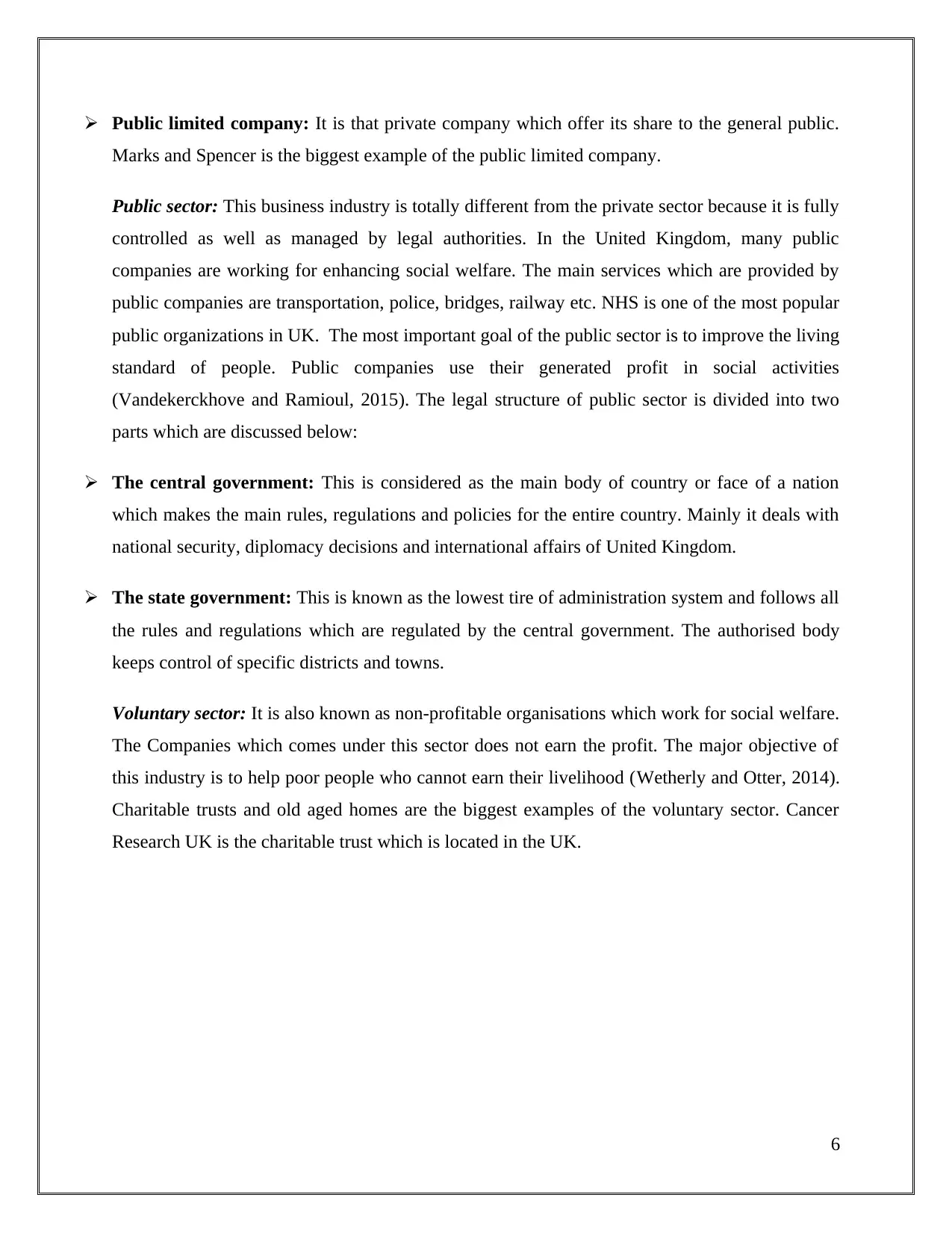
Public limited company: It is that private company which offer its share to the general public.
Marks and Spencer is the biggest example of the public limited company.
Public sector: This business industry is totally different from the private sector because it is fully
controlled as well as managed by legal authorities. In the United Kingdom, many public
companies are working for enhancing social welfare. The main services which are provided by
public companies are transportation, police, bridges, railway etc. NHS is one of the most popular
public organizations in UK. The most important goal of the public sector is to improve the living
standard of people. Public companies use their generated profit in social activities
(Vandekerckhove and Ramioul, 2015). The legal structure of public sector is divided into two
parts which are discussed below:
The central government: This is considered as the main body of country or face of a nation
which makes the main rules, regulations and policies for the entire country. Mainly it deals with
national security, diplomacy decisions and international affairs of United Kingdom.
The state government: This is known as the lowest tire of administration system and follows all
the rules and regulations which are regulated by the central government. The authorised body
keeps control of specific districts and towns.
Voluntary sector: It is also known as non-profitable organisations which work for social welfare.
The Companies which comes under this sector does not earn the profit. The major objective of
this industry is to help poor people who cannot earn their livelihood (Wetherly and Otter, 2014).
Charitable trusts and old aged homes are the biggest examples of the voluntary sector. Cancer
Research UK is the charitable trust which is located in the UK.
6
Marks and Spencer is the biggest example of the public limited company.
Public sector: This business industry is totally different from the private sector because it is fully
controlled as well as managed by legal authorities. In the United Kingdom, many public
companies are working for enhancing social welfare. The main services which are provided by
public companies are transportation, police, bridges, railway etc. NHS is one of the most popular
public organizations in UK. The most important goal of the public sector is to improve the living
standard of people. Public companies use their generated profit in social activities
(Vandekerckhove and Ramioul, 2015). The legal structure of public sector is divided into two
parts which are discussed below:
The central government: This is considered as the main body of country or face of a nation
which makes the main rules, regulations and policies for the entire country. Mainly it deals with
national security, diplomacy decisions and international affairs of United Kingdom.
The state government: This is known as the lowest tire of administration system and follows all
the rules and regulations which are regulated by the central government. The authorised body
keeps control of specific districts and towns.
Voluntary sector: It is also known as non-profitable organisations which work for social welfare.
The Companies which comes under this sector does not earn the profit. The major objective of
this industry is to help poor people who cannot earn their livelihood (Wetherly and Otter, 2014).
Charitable trusts and old aged homes are the biggest examples of the voluntary sector. Cancer
Research UK is the charitable trust which is located in the UK.
6

P2 Explain the size and scope of a range of different types of organisations
All business enterprises have their own size and scope which makes them different from other
organisations. Different types of organization and their size, as well as scope, are determined in
below-mentioned points:
Private sector: Marks and Spencer is a private partnership firm which is specialised in selling
designer clothes, household products and food items. This company was established in 1884 by
two founders Michael Marks and Thomas Spencer (Wu, et. al., 2015). It is a large organisation
and strength of its employees is also huge which is near around 85,989. The biggest objective of
this company is to enlarge organisational growth and to increase its sales revenue by providing
high customer satisfaction. Net operating income of this organisation is approx. around £690.7
million and net profit is £115.8 million till 2017.
Public sector: Public companies are mainly managed by authorised bodies of a country such as
central or local government. National Health Services is one of the leading public organizations
of United Kingdom which provides health and social care services to UK people so that they can
live the healthy life. This size of National Health Service is medium because it has strength of
6500 employees. It has more than 50 branches in all over England. The biggest objectives of
NHS are to deliver healthcare services in an innovative manner. The net expenditure of this
organization is near around £120.512 billion whereas its net income is £280.23 billion.
Voluntary sector: Cancer Research UK is the biggest example of voluntary sector which is a
charitable firm and makes people aware about cancer and its causes so that they can take care of
their self (Yüksel, 2012). The main objective of this non-profitable organisation is to reduce the
number of people who die because of cancer. It is small frim which employs near about 4000
employees.
7
All business enterprises have their own size and scope which makes them different from other
organisations. Different types of organization and their size, as well as scope, are determined in
below-mentioned points:
Private sector: Marks and Spencer is a private partnership firm which is specialised in selling
designer clothes, household products and food items. This company was established in 1884 by
two founders Michael Marks and Thomas Spencer (Wu, et. al., 2015). It is a large organisation
and strength of its employees is also huge which is near around 85,989. The biggest objective of
this company is to enlarge organisational growth and to increase its sales revenue by providing
high customer satisfaction. Net operating income of this organisation is approx. around £690.7
million and net profit is £115.8 million till 2017.
Public sector: Public companies are mainly managed by authorised bodies of a country such as
central or local government. National Health Services is one of the leading public organizations
of United Kingdom which provides health and social care services to UK people so that they can
live the healthy life. This size of National Health Service is medium because it has strength of
6500 employees. It has more than 50 branches in all over England. The biggest objectives of
NHS are to deliver healthcare services in an innovative manner. The net expenditure of this
organization is near around £120.512 billion whereas its net income is £280.23 billion.
Voluntary sector: Cancer Research UK is the biggest example of voluntary sector which is a
charitable firm and makes people aware about cancer and its causes so that they can take care of
their self (Yüksel, 2012). The main objective of this non-profitable organisation is to reduce the
number of people who die because of cancer. It is small frim which employs near about 4000
employees.
7
Paraphrase This Document
Need a fresh take? Get an instant paraphrase of this document with our AI Paraphraser

M1 Analyse how the structure, size and scope of different organisations link to the business
objectives and product and services offered by the organisation.
The size, scope and structure of the organization are highly influenced by business objectives
because manager set that organisational structure which helps them in accomplishing their
desired goals in the appropriate manner. For example, Marks and Spencer is large organisation
and for managing all workers it follows flexible structure. The organisational structure allows
employees to operate their given task in the most effective manner which influences positive
impact on organisational profit of Marks and Spencer (Foss, et. al., 2013).
The main objective of this Marks and Spencer is profit maximisation and customer satisfaction
which it achieves by taking help of its employees. They produce such quality products which
help an organization in achieving its desired objectives.
8
objectives and product and services offered by the organisation.
The size, scope and structure of the organization are highly influenced by business objectives
because manager set that organisational structure which helps them in accomplishing their
desired goals in the appropriate manner. For example, Marks and Spencer is large organisation
and for managing all workers it follows flexible structure. The organisational structure allows
employees to operate their given task in the most effective manner which influences positive
impact on organisational profit of Marks and Spencer (Foss, et. al., 2013).
The main objective of this Marks and Spencer is profit maximisation and customer satisfaction
which it achieves by taking help of its employees. They produce such quality products which
help an organization in achieving its desired objectives.
8
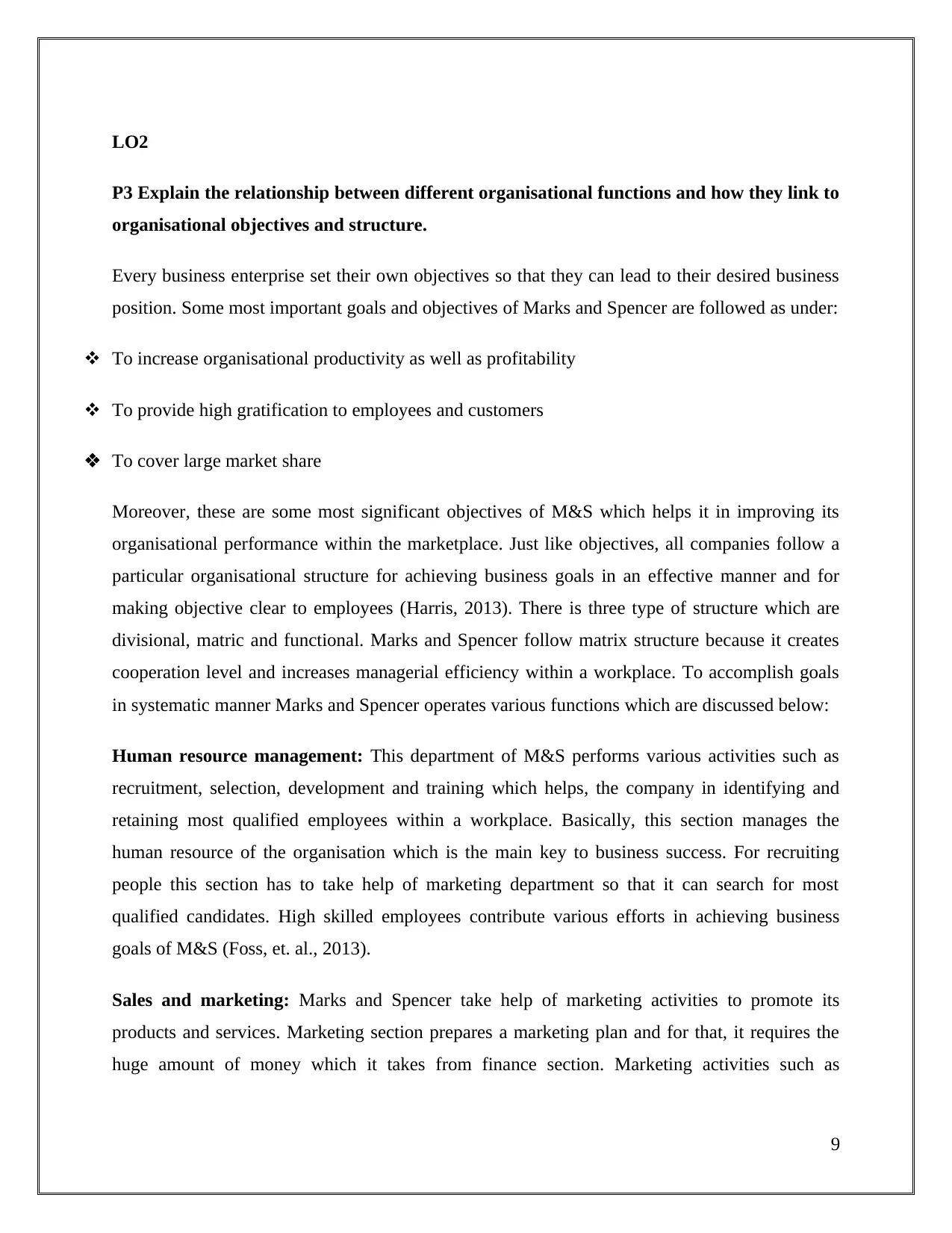
LO2
P3 Explain the relationship between different organisational functions and how they link to
organisational objectives and structure.
Every business enterprise set their own objectives so that they can lead to their desired business
position. Some most important goals and objectives of Marks and Spencer are followed as under:
To increase organisational productivity as well as profitability
To provide high gratification to employees and customers
To cover large market share
Moreover, these are some most significant objectives of M&S which helps it in improving its
organisational performance within the marketplace. Just like objectives, all companies follow a
particular organisational structure for achieving business goals in an effective manner and for
making objective clear to employees (Harris, 2013). There is three type of structure which are
divisional, matric and functional. Marks and Spencer follow matrix structure because it creates
cooperation level and increases managerial efficiency within a workplace. To accomplish goals
in systematic manner Marks and Spencer operates various functions which are discussed below:
Human resource management: This department of M&S performs various activities such as
recruitment, selection, development and training which helps, the company in identifying and
retaining most qualified employees within a workplace. Basically, this section manages the
human resource of the organisation which is the main key to business success. For recruiting
people this section has to take help of marketing department so that it can search for most
qualified candidates. High skilled employees contribute various efforts in achieving business
goals of M&S (Foss, et. al., 2013).
Sales and marketing: Marks and Spencer take help of marketing activities to promote its
products and services. Marketing section prepares a marketing plan and for that, it requires the
huge amount of money which it takes from finance section. Marketing activities such as
9
P3 Explain the relationship between different organisational functions and how they link to
organisational objectives and structure.
Every business enterprise set their own objectives so that they can lead to their desired business
position. Some most important goals and objectives of Marks and Spencer are followed as under:
To increase organisational productivity as well as profitability
To provide high gratification to employees and customers
To cover large market share
Moreover, these are some most significant objectives of M&S which helps it in improving its
organisational performance within the marketplace. Just like objectives, all companies follow a
particular organisational structure for achieving business goals in an effective manner and for
making objective clear to employees (Harris, 2013). There is three type of structure which are
divisional, matric and functional. Marks and Spencer follow matrix structure because it creates
cooperation level and increases managerial efficiency within a workplace. To accomplish goals
in systematic manner Marks and Spencer operates various functions which are discussed below:
Human resource management: This department of M&S performs various activities such as
recruitment, selection, development and training which helps, the company in identifying and
retaining most qualified employees within a workplace. Basically, this section manages the
human resource of the organisation which is the main key to business success. For recruiting
people this section has to take help of marketing department so that it can search for most
qualified candidates. High skilled employees contribute various efforts in achieving business
goals of M&S (Foss, et. al., 2013).
Sales and marketing: Marks and Spencer take help of marketing activities to promote its
products and services. Marketing section prepares a marketing plan and for that, it requires the
huge amount of money which it takes from finance section. Marketing activities such as
9

promotion and advertisement help in attracting the huge number of people which basically, helps
M&S in increasing its market share.
Finance: This section keeps control on the daily monetary transactions of Marks and Spencer.
On the basis of market research, it estimates the capital which will be required for operating
future operations of the company (Harris, 2013).
Marks and Spencer is a large organization and operates various functions that are why it follows
Matrix structure which also assists it in creating the flexible working environment.
10
M&S in increasing its market share.
Finance: This section keeps control on the daily monetary transactions of Marks and Spencer.
On the basis of market research, it estimates the capital which will be required for operating
future operations of the company (Harris, 2013).
Marks and Spencer is a large organization and operates various functions that are why it follows
Matrix structure which also assists it in creating the flexible working environment.
10
Secure Best Marks with AI Grader
Need help grading? Try our AI Grader for instant feedback on your assignments.
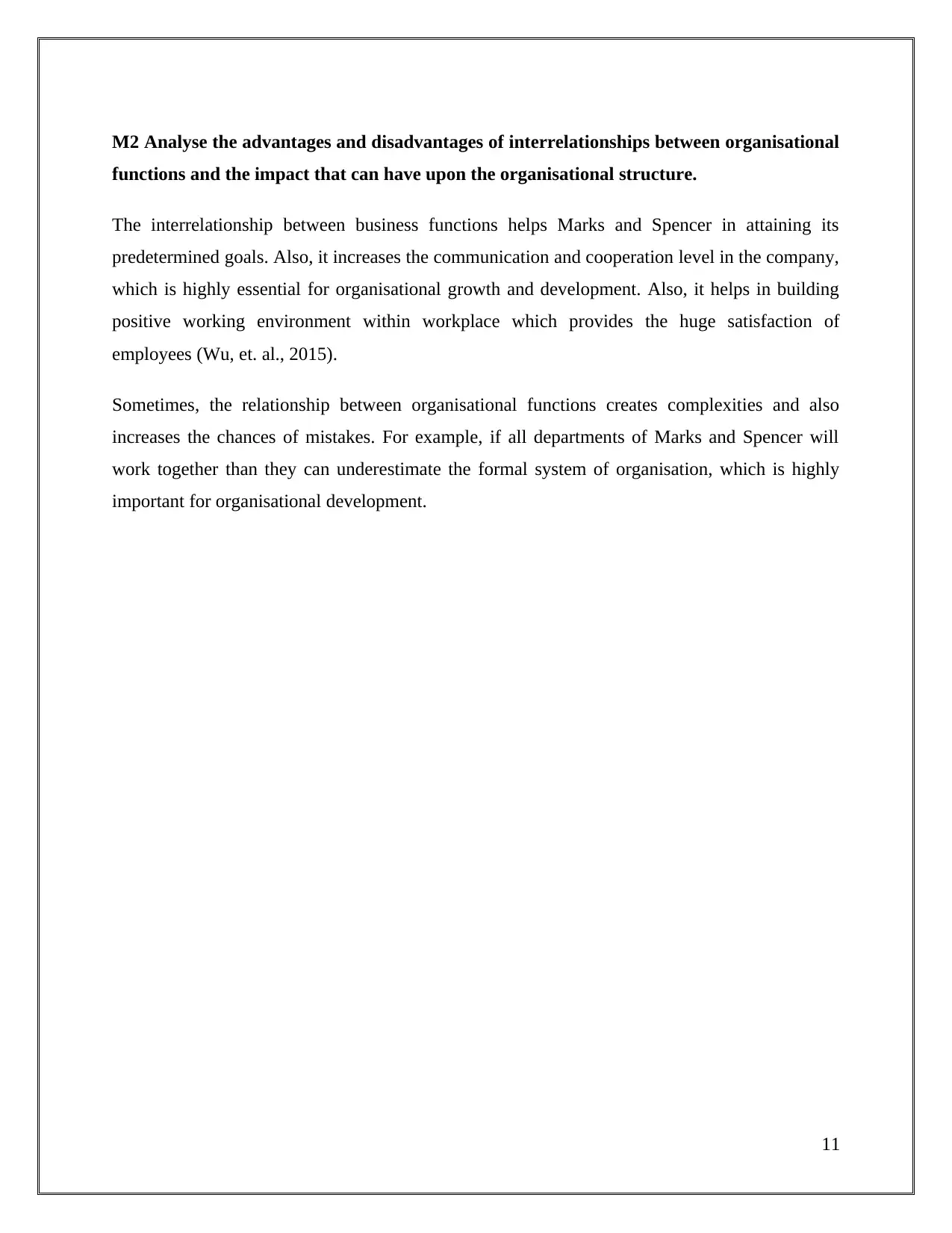
M2 Analyse the advantages and disadvantages of interrelationships between organisational
functions and the impact that can have upon the organisational structure.
The interrelationship between business functions helps Marks and Spencer in attaining its
predetermined goals. Also, it increases the communication and cooperation level in the company,
which is highly essential for organisational growth and development. Also, it helps in building
positive working environment within workplace which provides the huge satisfaction of
employees (Wu, et. al., 2015).
Sometimes, the relationship between organisational functions creates complexities and also
increases the chances of mistakes. For example, if all departments of Marks and Spencer will
work together than they can underestimate the formal system of organisation, which is highly
important for organisational development.
11
functions and the impact that can have upon the organisational structure.
The interrelationship between business functions helps Marks and Spencer in attaining its
predetermined goals. Also, it increases the communication and cooperation level in the company,
which is highly essential for organisational growth and development. Also, it helps in building
positive working environment within workplace which provides the huge satisfaction of
employees (Wu, et. al., 2015).
Sometimes, the relationship between organisational functions creates complexities and also
increases the chances of mistakes. For example, if all departments of Marks and Spencer will
work together than they can underestimate the formal system of organisation, which is highly
important for organisational development.
11

D1 Provide a critical analysis of the complexities of different types of business structure
and the interrelationships of the different organisational functions.
According to Yüksel (2012), the interrelationship between business functions creates chances of
false or mistakes. Also, it affects the formal system of organisation. Apart from this, a business
enterprise should select that organisational structure according to their business size and
objectives. The complexities that take place in the organisational functions are made due to the
interdependence of different functional units in them. This is made for the production of products
and services for the attainment of profits. Due to the interdependence, the consumption of time
gets increased and the productivity gets reduced. Basically, there are three types of
organisational structure which are divisional, matrix and divisional. Complexities of all
organisational structure are followed as under:
Functional structure: In this business structure, all important decisions are taken by managers
which do not allow employees to take part in decisions making process. This influence negative
impact on workers and demotivates them.
Matrix structure: In this organisational structure all departments work with each other which
make reporting line unclear and also confuse the employees.
Divisional structure: The biggest advantage of this organisational structure is that it creates the
sense of competition within business divisions.
12
and the interrelationships of the different organisational functions.
According to Yüksel (2012), the interrelationship between business functions creates chances of
false or mistakes. Also, it affects the formal system of organisation. Apart from this, a business
enterprise should select that organisational structure according to their business size and
objectives. The complexities that take place in the organisational functions are made due to the
interdependence of different functional units in them. This is made for the production of products
and services for the attainment of profits. Due to the interdependence, the consumption of time
gets increased and the productivity gets reduced. Basically, there are three types of
organisational structure which are divisional, matrix and divisional. Complexities of all
organisational structure are followed as under:
Functional structure: In this business structure, all important decisions are taken by managers
which do not allow employees to take part in decisions making process. This influence negative
impact on workers and demotivates them.
Matrix structure: In this organisational structure all departments work with each other which
make reporting line unclear and also confuse the employees.
Divisional structure: The biggest advantage of this organisational structure is that it creates the
sense of competition within business divisions.
12
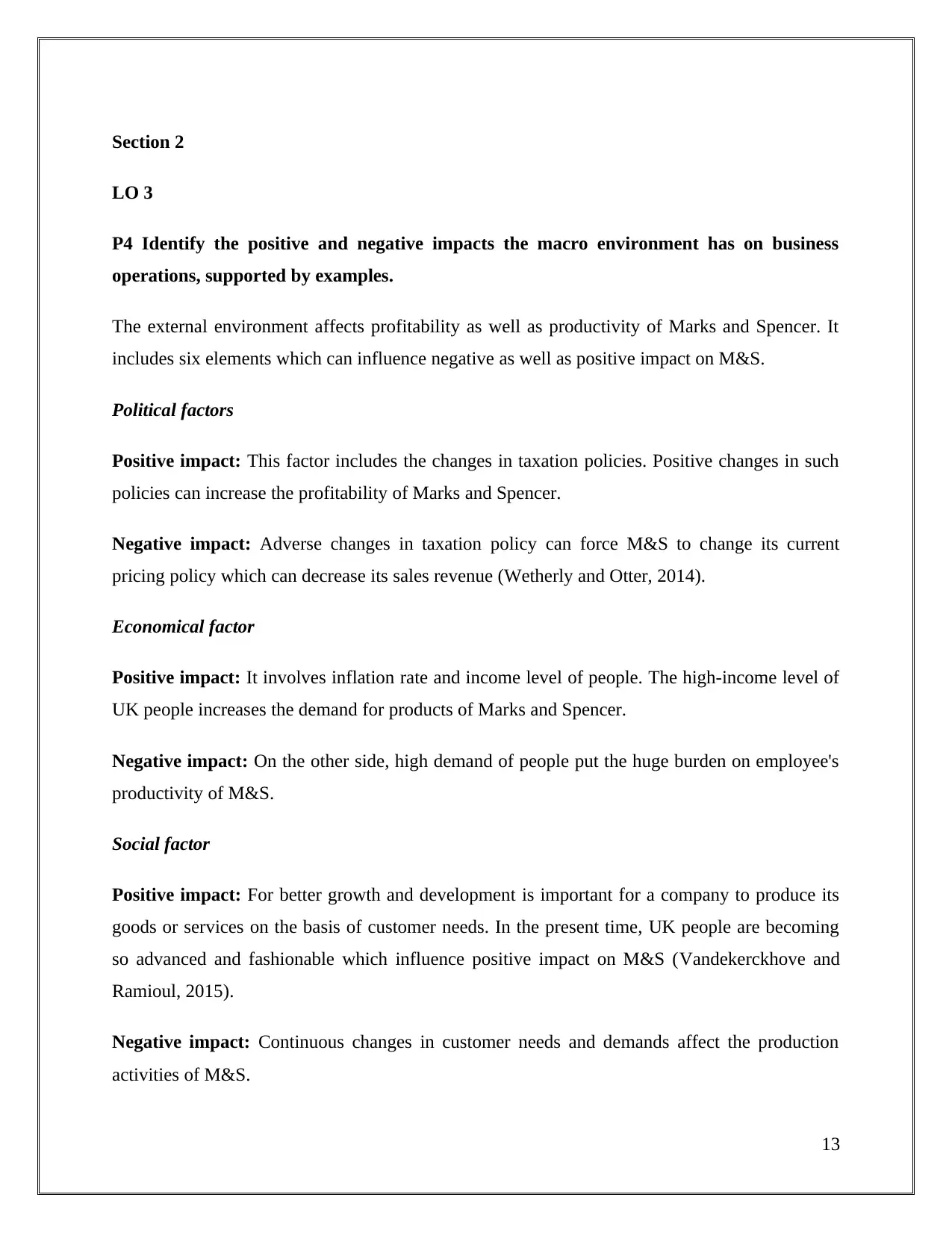
Section 2
LO 3
P4 Identify the positive and negative impacts the macro environment has on business
operations, supported by examples.
The external environment affects profitability as well as productivity of Marks and Spencer. It
includes six elements which can influence negative as well as positive impact on M&S.
Political factors
Positive impact: This factor includes the changes in taxation policies. Positive changes in such
policies can increase the profitability of Marks and Spencer.
Negative impact: Adverse changes in taxation policy can force M&S to change its current
pricing policy which can decrease its sales revenue (Wetherly and Otter, 2014).
Economical factor
Positive impact: It involves inflation rate and income level of people. The high-income level of
UK people increases the demand for products of Marks and Spencer.
Negative impact: On the other side, high demand of people put the huge burden on employee's
productivity of M&S.
Social factor
Positive impact: For better growth and development is important for a company to produce its
goods or services on the basis of customer needs. In the present time, UK people are becoming
so advanced and fashionable which influence positive impact on M&S (Vandekerckhove and
Ramioul, 2015).
Negative impact: Continuous changes in customer needs and demands affect the production
activities of M&S.
13
LO 3
P4 Identify the positive and negative impacts the macro environment has on business
operations, supported by examples.
The external environment affects profitability as well as productivity of Marks and Spencer. It
includes six elements which can influence negative as well as positive impact on M&S.
Political factors
Positive impact: This factor includes the changes in taxation policies. Positive changes in such
policies can increase the profitability of Marks and Spencer.
Negative impact: Adverse changes in taxation policy can force M&S to change its current
pricing policy which can decrease its sales revenue (Wetherly and Otter, 2014).
Economical factor
Positive impact: It involves inflation rate and income level of people. The high-income level of
UK people increases the demand for products of Marks and Spencer.
Negative impact: On the other side, high demand of people put the huge burden on employee's
productivity of M&S.
Social factor
Positive impact: For better growth and development is important for a company to produce its
goods or services on the basis of customer needs. In the present time, UK people are becoming
so advanced and fashionable which influence positive impact on M&S (Vandekerckhove and
Ramioul, 2015).
Negative impact: Continuous changes in customer needs and demands affect the production
activities of M&S.
13
Paraphrase This Document
Need a fresh take? Get an instant paraphrase of this document with our AI Paraphraser
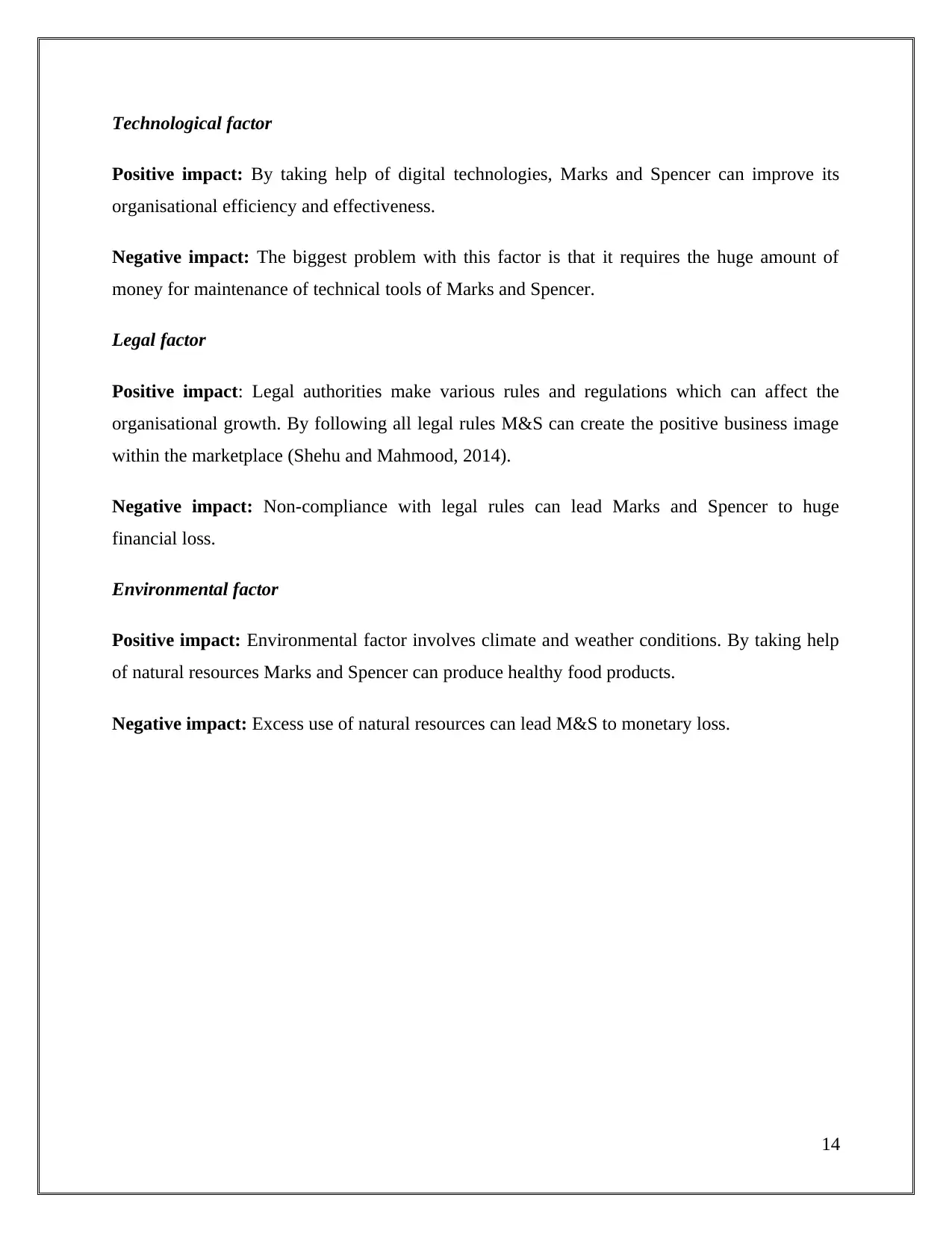
Technological factor
Positive impact: By taking help of digital technologies, Marks and Spencer can improve its
organisational efficiency and effectiveness.
Negative impact: The biggest problem with this factor is that it requires the huge amount of
money for maintenance of technical tools of Marks and Spencer.
Legal factor
Positive impact: Legal authorities make various rules and regulations which can affect the
organisational growth. By following all legal rules M&S can create the positive business image
within the marketplace (Shehu and Mahmood, 2014).
Negative impact: Non-compliance with legal rules can lead Marks and Spencer to huge
financial loss.
Environmental factor
Positive impact: Environmental factor involves climate and weather conditions. By taking help
of natural resources Marks and Spencer can produce healthy food products.
Negative impact: Excess use of natural resources can lead M&S to monetary loss.
14
Positive impact: By taking help of digital technologies, Marks and Spencer can improve its
organisational efficiency and effectiveness.
Negative impact: The biggest problem with this factor is that it requires the huge amount of
money for maintenance of technical tools of Marks and Spencer.
Legal factor
Positive impact: Legal authorities make various rules and regulations which can affect the
organisational growth. By following all legal rules M&S can create the positive business image
within the marketplace (Shehu and Mahmood, 2014).
Negative impact: Non-compliance with legal rules can lead Marks and Spencer to huge
financial loss.
Environmental factor
Positive impact: Environmental factor involves climate and weather conditions. By taking help
of natural resources Marks and Spencer can produce healthy food products.
Negative impact: Excess use of natural resources can lead M&S to monetary loss.
14
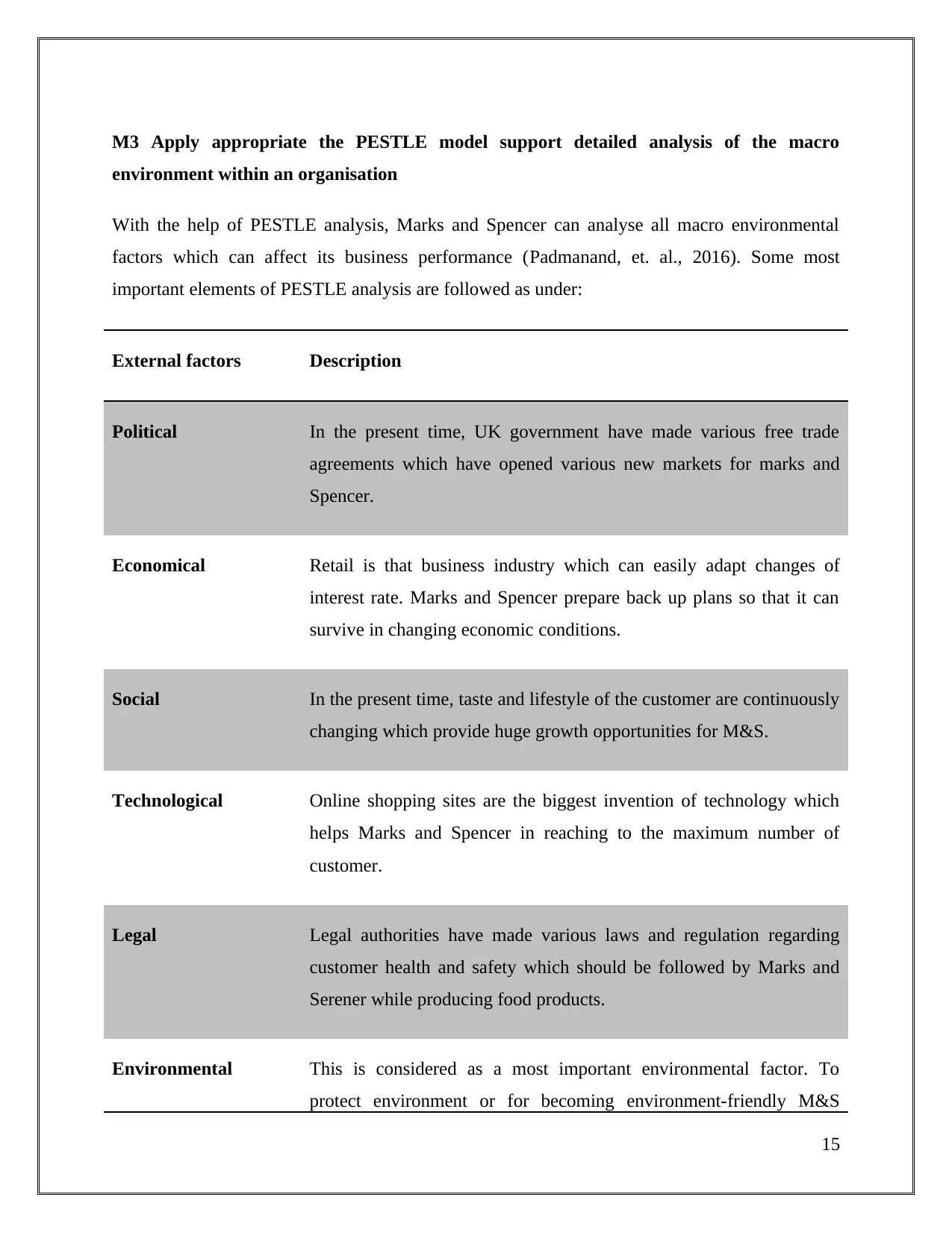
M3 Apply appropriate the PESTLE model support detailed analysis of the macro
environment within an organisation
With the help of PESTLE analysis, Marks and Spencer can analyse all macro environmental
factors which can affect its business performance (Padmanand, et. al., 2016). Some most
important elements of PESTLE analysis are followed as under:
External factors Description
Political In the present time, UK government have made various free trade
agreements which have opened various new markets for marks and
Spencer.
Economical Retail is that business industry which can easily adapt changes of
interest rate. Marks and Spencer prepare back up plans so that it can
survive in changing economic conditions.
Social In the present time, taste and lifestyle of the customer are continuously
changing which provide huge growth opportunities for M&S.
Technological Online shopping sites are the biggest invention of technology which
helps Marks and Spencer in reaching to the maximum number of
customer.
Legal Legal authorities have made various laws and regulation regarding
customer health and safety which should be followed by Marks and
Serener while producing food products.
Environmental This is considered as a most important environmental factor. To
protect environment or for becoming environment-friendly M&S
15
environment within an organisation
With the help of PESTLE analysis, Marks and Spencer can analyse all macro environmental
factors which can affect its business performance (Padmanand, et. al., 2016). Some most
important elements of PESTLE analysis are followed as under:
External factors Description
Political In the present time, UK government have made various free trade
agreements which have opened various new markets for marks and
Spencer.
Economical Retail is that business industry which can easily adapt changes of
interest rate. Marks and Spencer prepare back up plans so that it can
survive in changing economic conditions.
Social In the present time, taste and lifestyle of the customer are continuously
changing which provide huge growth opportunities for M&S.
Technological Online shopping sites are the biggest invention of technology which
helps Marks and Spencer in reaching to the maximum number of
customer.
Legal Legal authorities have made various laws and regulation regarding
customer health and safety which should be followed by Marks and
Serener while producing food products.
Environmental This is considered as a most important environmental factor. To
protect environment or for becoming environment-friendly M&S
15
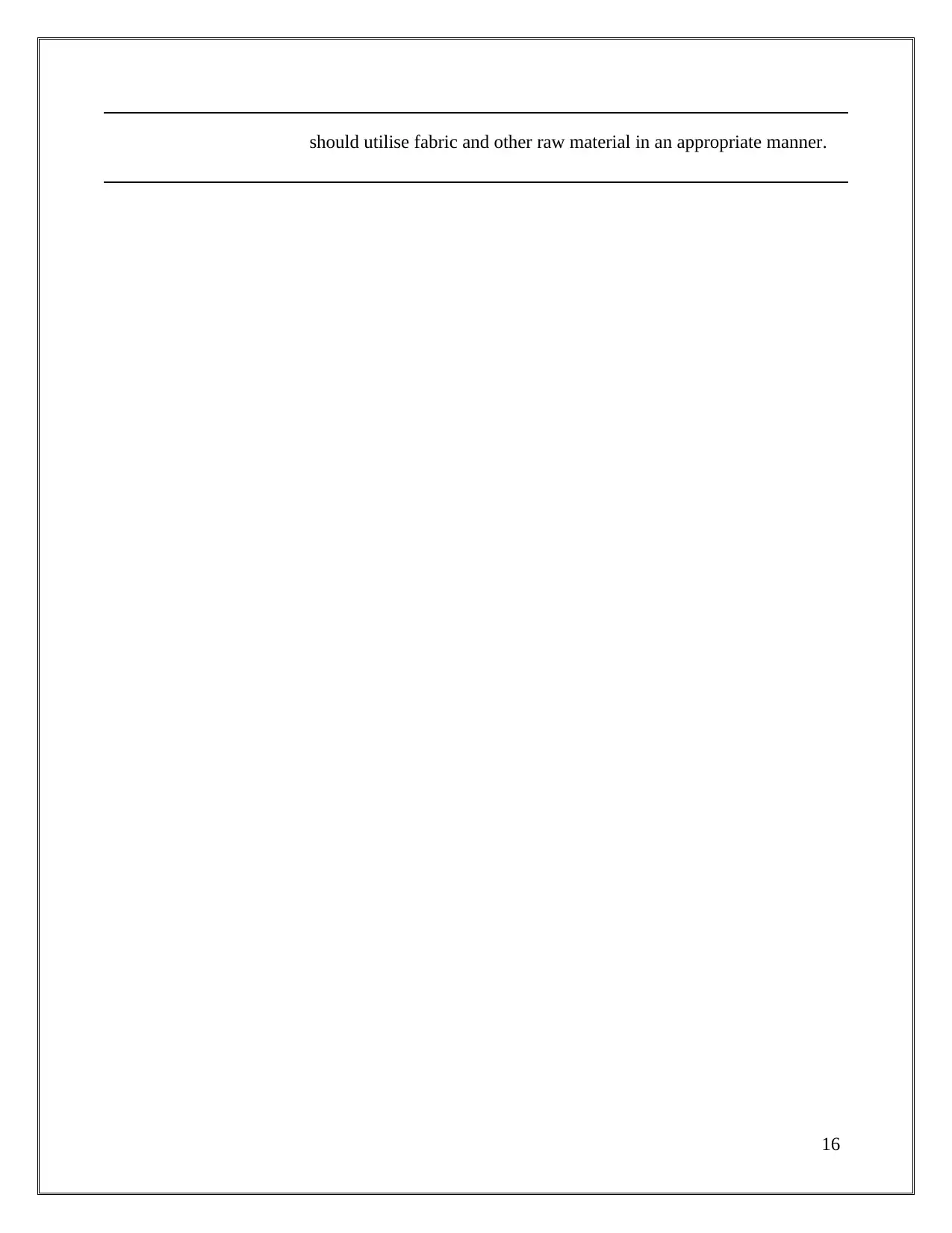
should utilise fabric and other raw material in an appropriate manner.
16
16
Secure Best Marks with AI Grader
Need help grading? Try our AI Grader for instant feedback on your assignments.
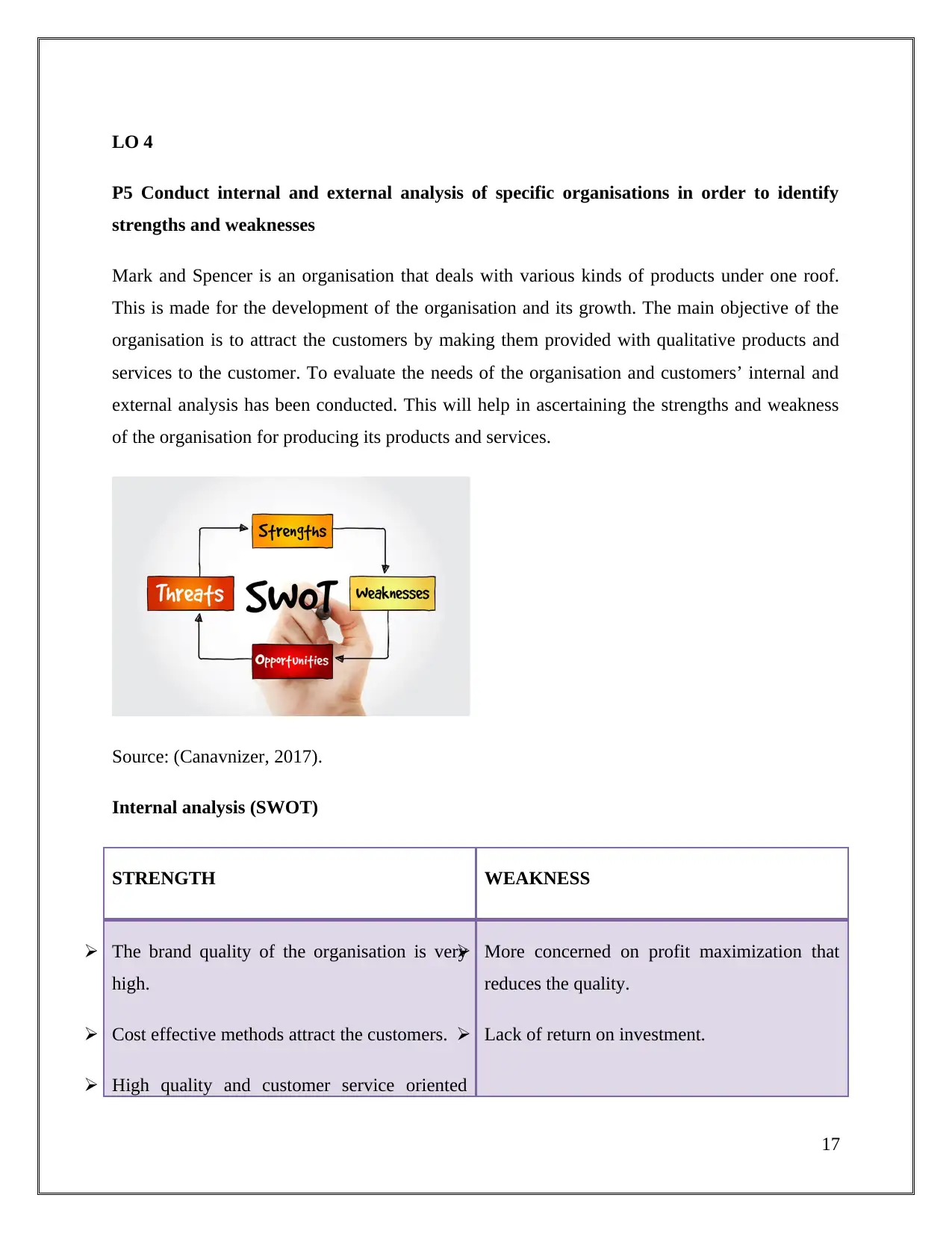
LO 4
P5 Conduct internal and external analysis of specific organisations in order to identify
strengths and weaknesses
Mark and Spencer is an organisation that deals with various kinds of products under one roof.
This is made for the development of the organisation and its growth. The main objective of the
organisation is to attract the customers by making them provided with qualitative products and
services to the customer. To evaluate the needs of the organisation and customers’ internal and
external analysis has been conducted. This will help in ascertaining the strengths and weakness
of the organisation for producing its products and services.
Source: (Canavnizer, 2017).
Internal analysis (SWOT)
STRENGTH WEAKNESS
The brand quality of the organisation is very
high.
Cost effective methods attract the customers.
High quality and customer service oriented
More concerned on profit maximization that
reduces the quality.
Lack of return on investment.
17
P5 Conduct internal and external analysis of specific organisations in order to identify
strengths and weaknesses
Mark and Spencer is an organisation that deals with various kinds of products under one roof.
This is made for the development of the organisation and its growth. The main objective of the
organisation is to attract the customers by making them provided with qualitative products and
services to the customer. To evaluate the needs of the organisation and customers’ internal and
external analysis has been conducted. This will help in ascertaining the strengths and weakness
of the organisation for producing its products and services.
Source: (Canavnizer, 2017).
Internal analysis (SWOT)
STRENGTH WEAKNESS
The brand quality of the organisation is very
high.
Cost effective methods attract the customers.
High quality and customer service oriented
More concerned on profit maximization that
reduces the quality.
Lack of return on investment.
17
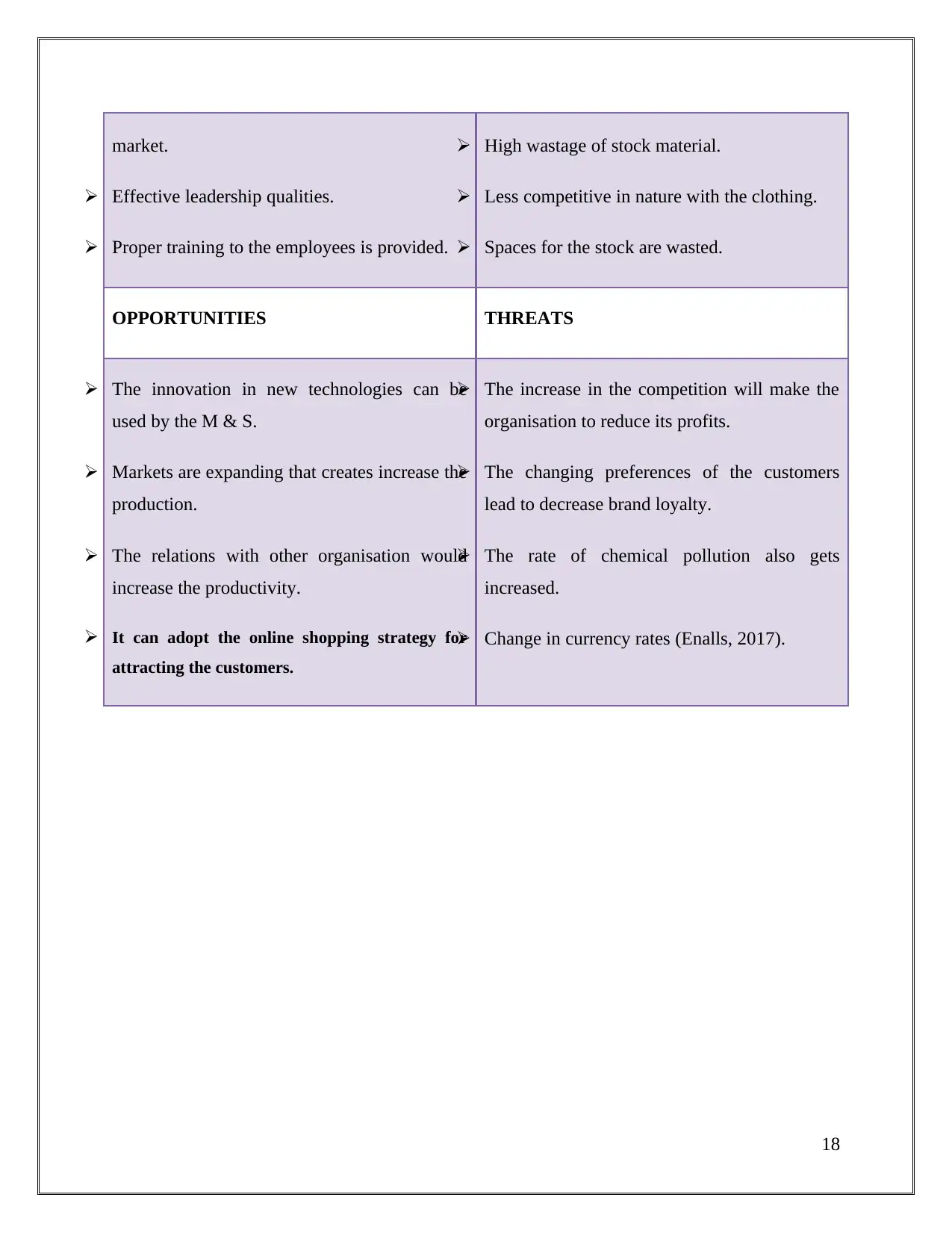
market.
Effective leadership qualities.
Proper training to the employees is provided.
High wastage of stock material.
Less competitive in nature with the clothing.
Spaces for the stock are wasted.
OPPORTUNITIES THREATS
The innovation in new technologies can be
used by the M & S.
Markets are expanding that creates increase the
production.
The relations with other organisation would
increase the productivity.
It can adopt the online shopping strategy for
attracting the customers.
The increase in the competition will make the
organisation to reduce its profits.
The changing preferences of the customers
lead to decrease brand loyalty.
The rate of chemical pollution also gets
increased.
Change in currency rates (Enalls, 2017).
18
Effective leadership qualities.
Proper training to the employees is provided.
High wastage of stock material.
Less competitive in nature with the clothing.
Spaces for the stock are wasted.
OPPORTUNITIES THREATS
The innovation in new technologies can be
used by the M & S.
Markets are expanding that creates increase the
production.
The relations with other organisation would
increase the productivity.
It can adopt the online shopping strategy for
attracting the customers.
The increase in the competition will make the
organisation to reduce its profits.
The changing preferences of the customers
lead to decrease brand loyalty.
The rate of chemical pollution also gets
increased.
Change in currency rates (Enalls, 2017).
18
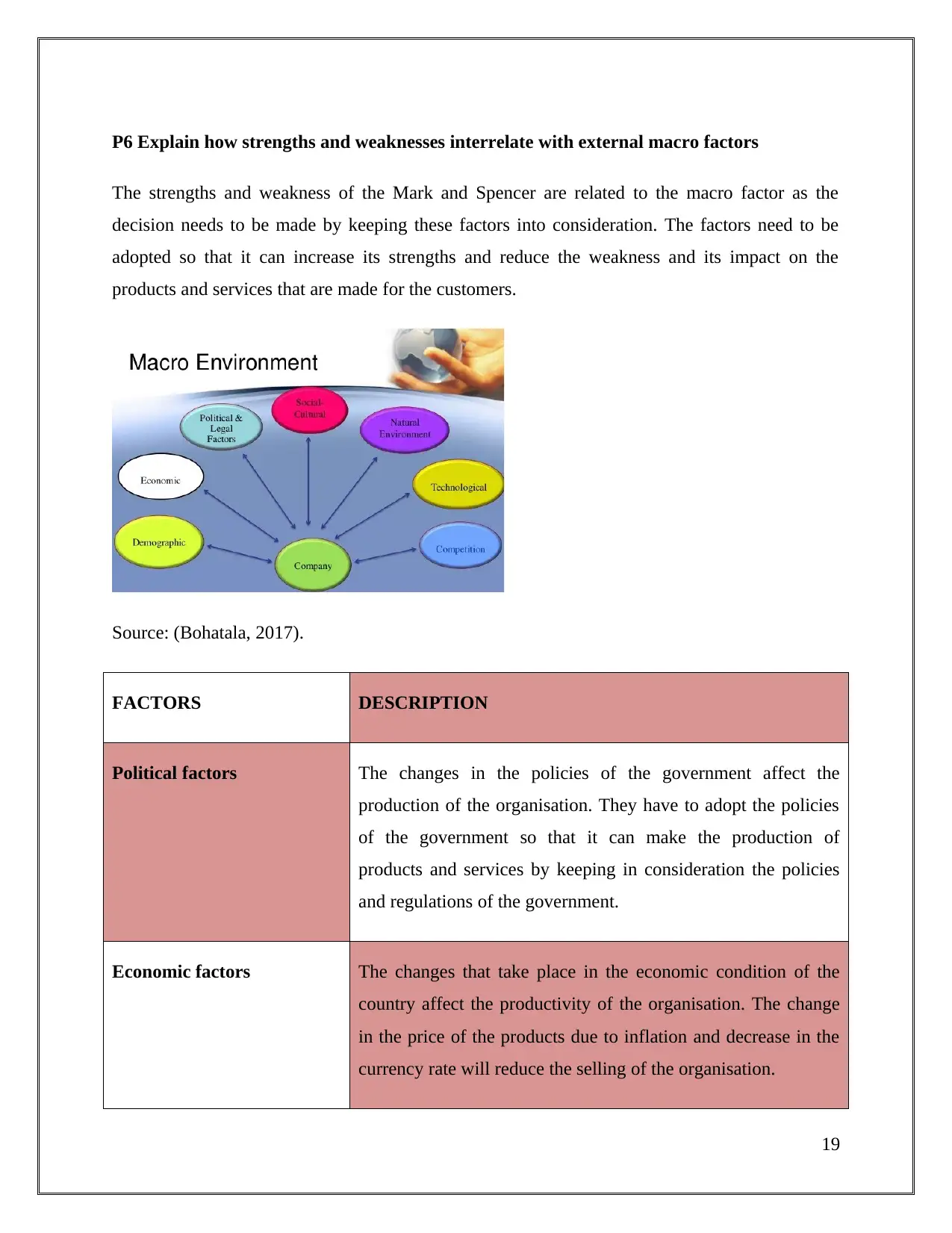
P6 Explain how strengths and weaknesses interrelate with external macro factors
The strengths and weakness of the Mark and Spencer are related to the macro factor as the
decision needs to be made by keeping these factors into consideration. The factors need to be
adopted so that it can increase its strengths and reduce the weakness and its impact on the
products and services that are made for the customers.
Source: (Bohatala, 2017).
FACTORS DESCRIPTION
Political factors The changes in the policies of the government affect the
production of the organisation. They have to adopt the policies
of the government so that it can make the production of
products and services by keeping in consideration the policies
and regulations of the government.
Economic factors The changes that take place in the economic condition of the
country affect the productivity of the organisation. The change
in the price of the products due to inflation and decrease in the
currency rate will reduce the selling of the organisation.
19
The strengths and weakness of the Mark and Spencer are related to the macro factor as the
decision needs to be made by keeping these factors into consideration. The factors need to be
adopted so that it can increase its strengths and reduce the weakness and its impact on the
products and services that are made for the customers.
Source: (Bohatala, 2017).
FACTORS DESCRIPTION
Political factors The changes in the policies of the government affect the
production of the organisation. They have to adopt the policies
of the government so that it can make the production of
products and services by keeping in consideration the policies
and regulations of the government.
Economic factors The changes that take place in the economic condition of the
country affect the productivity of the organisation. The change
in the price of the products due to inflation and decrease in the
currency rate will reduce the selling of the organisation.
19
Paraphrase This Document
Need a fresh take? Get an instant paraphrase of this document with our AI Paraphraser
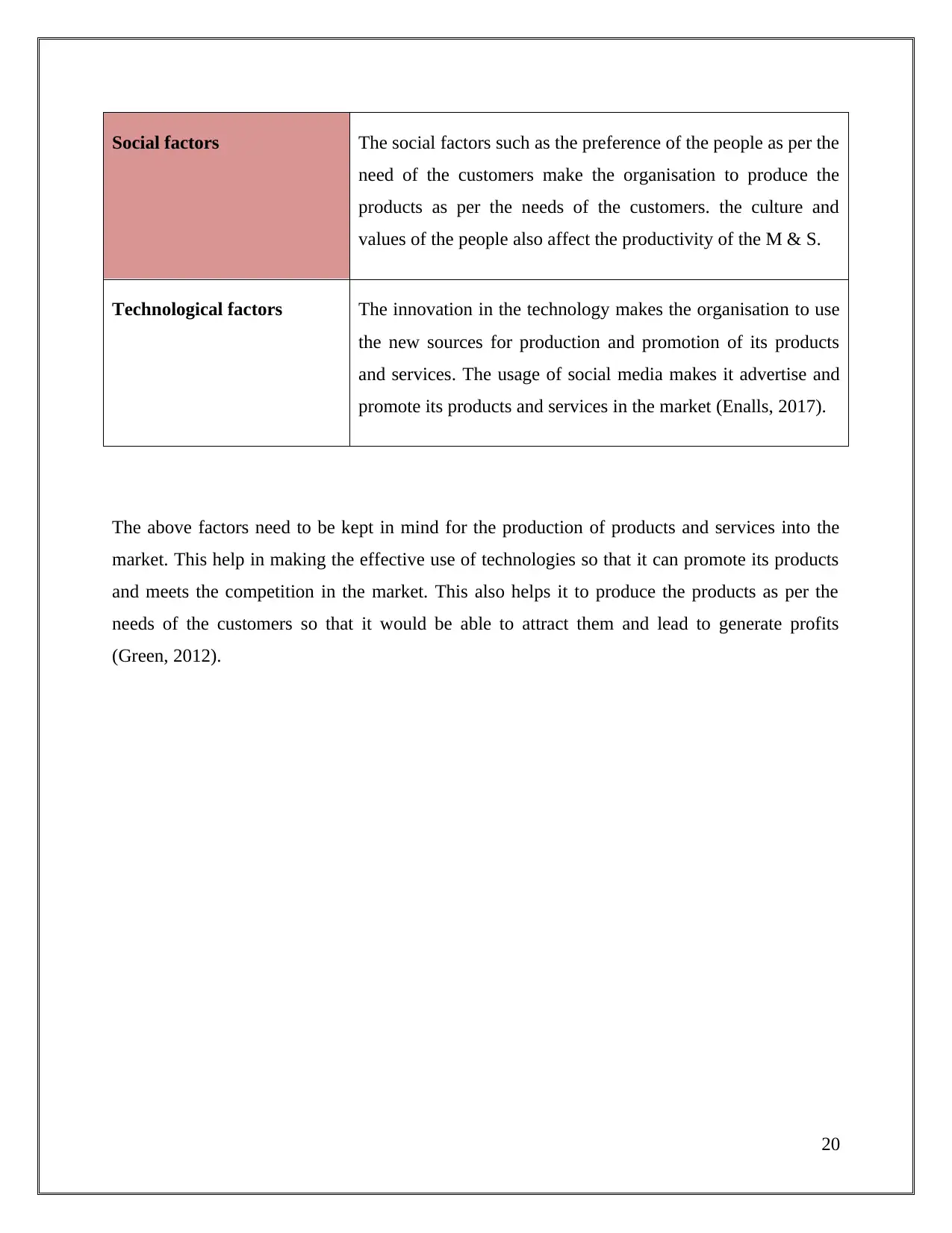
Social factors The social factors such as the preference of the people as per the
need of the customers make the organisation to produce the
products as per the needs of the customers. the culture and
values of the people also affect the productivity of the M & S.
Technological factors The innovation in the technology makes the organisation to use
the new sources for production and promotion of its products
and services. The usage of social media makes it advertise and
promote its products and services in the market (Enalls, 2017).
The above factors need to be kept in mind for the production of products and services into the
market. This help in making the effective use of technologies so that it can promote its products
and meets the competition in the market. This also helps it to produce the products as per the
needs of the customers so that it would be able to attract them and lead to generate profits
(Green, 2012).
20
need of the customers make the organisation to produce the
products as per the needs of the customers. the culture and
values of the people also affect the productivity of the M & S.
Technological factors The innovation in the technology makes the organisation to use
the new sources for production and promotion of its products
and services. The usage of social media makes it advertise and
promote its products and services in the market (Enalls, 2017).
The above factors need to be kept in mind for the production of products and services into the
market. This help in making the effective use of technologies so that it can promote its products
and meets the competition in the market. This also helps it to produce the products as per the
needs of the customers so that it would be able to attract them and lead to generate profits
(Green, 2012).
20
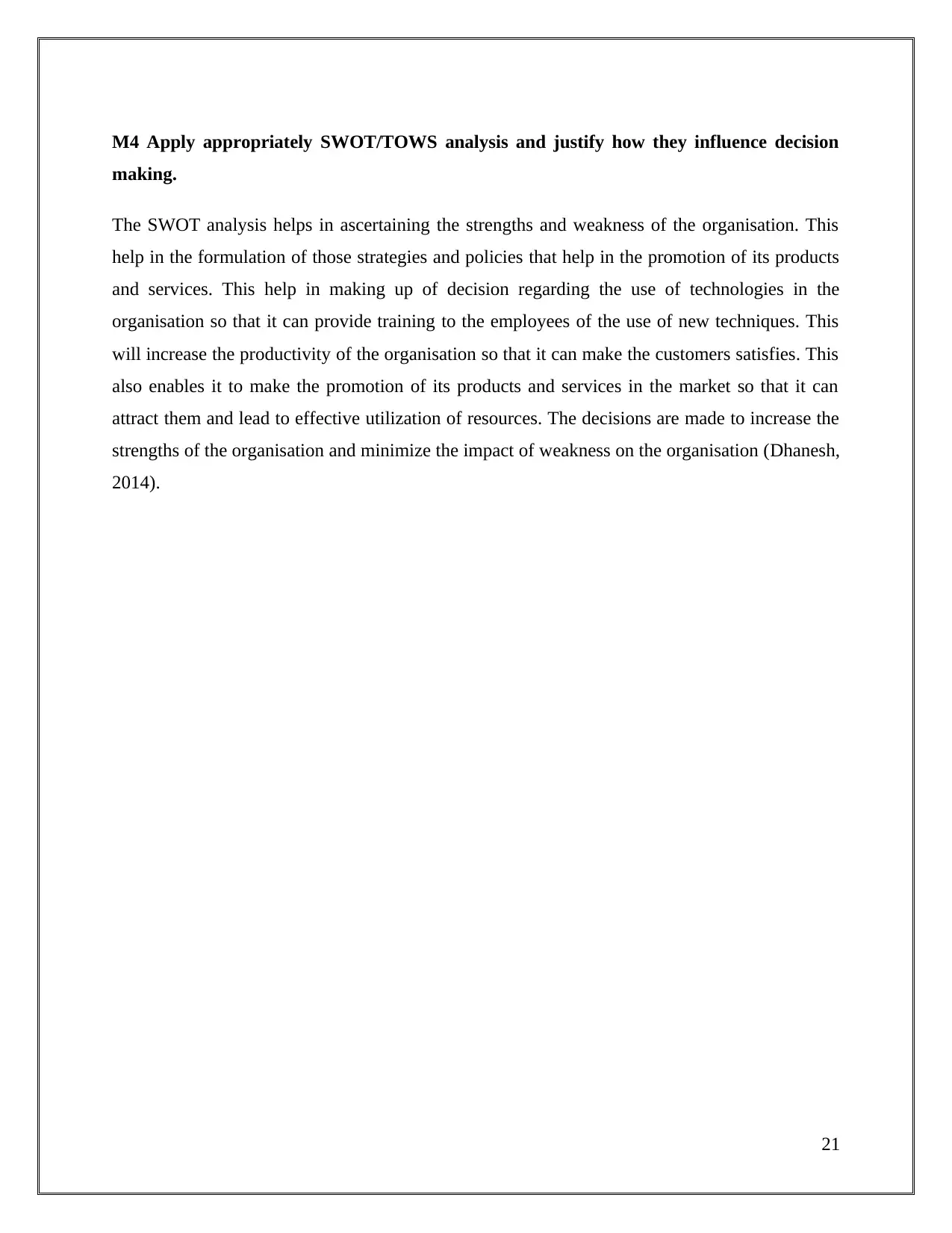
M4 Apply appropriately SWOT/TOWS analysis and justify how they influence decision
making.
The SWOT analysis helps in ascertaining the strengths and weakness of the organisation. This
help in the formulation of those strategies and policies that help in the promotion of its products
and services. This help in making up of decision regarding the use of technologies in the
organisation so that it can provide training to the employees of the use of new techniques. This
will increase the productivity of the organisation so that it can make the customers satisfies. This
also enables it to make the promotion of its products and services in the market so that it can
attract them and lead to effective utilization of resources. The decisions are made to increase the
strengths of the organisation and minimize the impact of weakness on the organisation (Dhanesh,
2014).
21
making.
The SWOT analysis helps in ascertaining the strengths and weakness of the organisation. This
help in the formulation of those strategies and policies that help in the promotion of its products
and services. This help in making up of decision regarding the use of technologies in the
organisation so that it can provide training to the employees of the use of new techniques. This
will increase the productivity of the organisation so that it can make the customers satisfies. This
also enables it to make the promotion of its products and services in the market so that it can
attract them and lead to effective utilization of resources. The decisions are made to increase the
strengths of the organisation and minimize the impact of weakness on the organisation (Dhanesh,
2014).
21
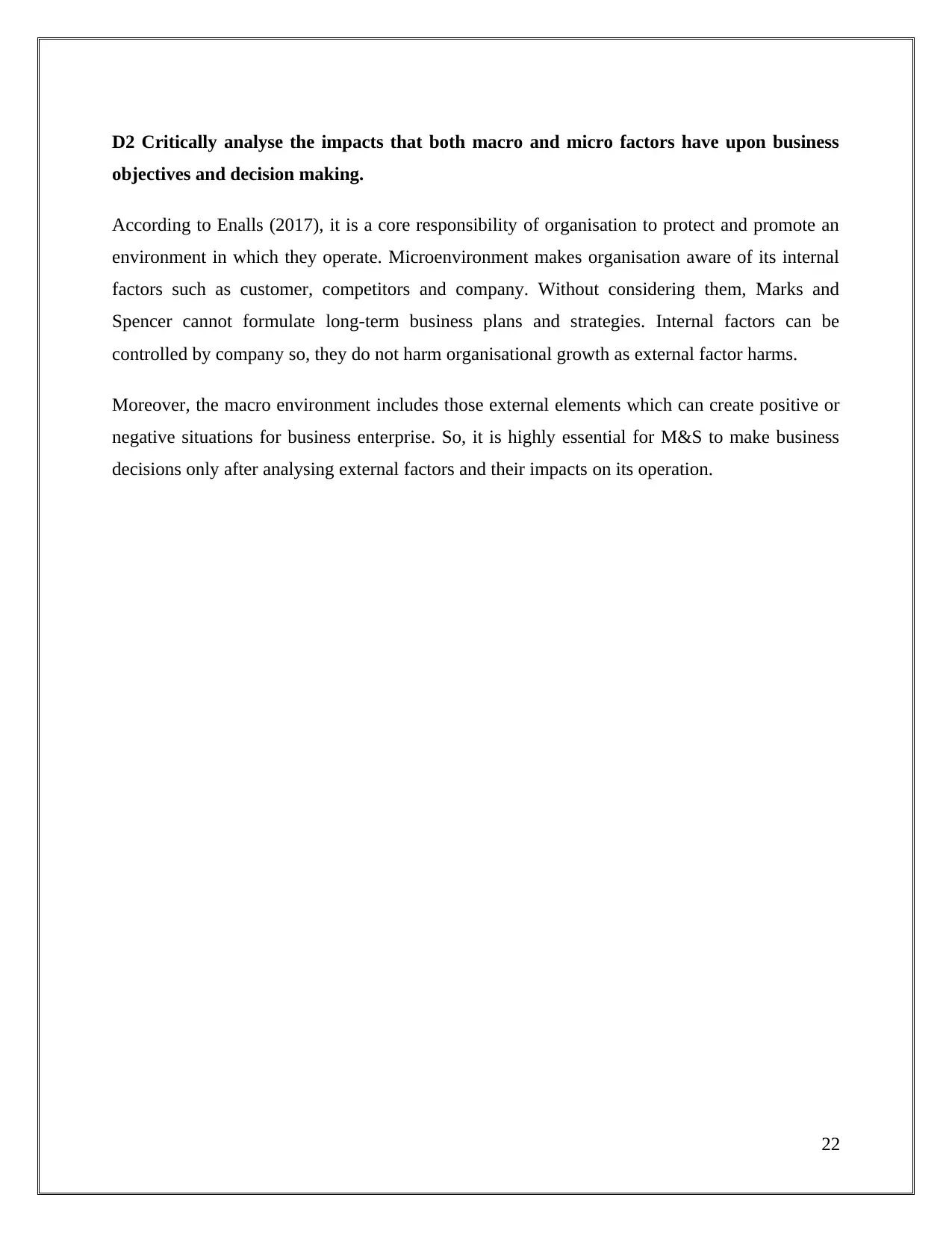
D2 Critically analyse the impacts that both macro and micro factors have upon business
objectives and decision making.
According to Enalls (2017), it is a core responsibility of organisation to protect and promote an
environment in which they operate. Microenvironment makes organisation aware of its internal
factors such as customer, competitors and company. Without considering them, Marks and
Spencer cannot formulate long-term business plans and strategies. Internal factors can be
controlled by company so, they do not harm organisational growth as external factor harms.
Moreover, the macro environment includes those external elements which can create positive or
negative situations for business enterprise. So, it is highly essential for M&S to make business
decisions only after analysing external factors and their impacts on its operation.
22
objectives and decision making.
According to Enalls (2017), it is a core responsibility of organisation to protect and promote an
environment in which they operate. Microenvironment makes organisation aware of its internal
factors such as customer, competitors and company. Without considering them, Marks and
Spencer cannot formulate long-term business plans and strategies. Internal factors can be
controlled by company so, they do not harm organisational growth as external factor harms.
Moreover, the macro environment includes those external elements which can create positive or
negative situations for business enterprise. So, it is highly essential for M&S to make business
decisions only after analysing external factors and their impacts on its operation.
22
Secure Best Marks with AI Grader
Need help grading? Try our AI Grader for instant feedback on your assignments.
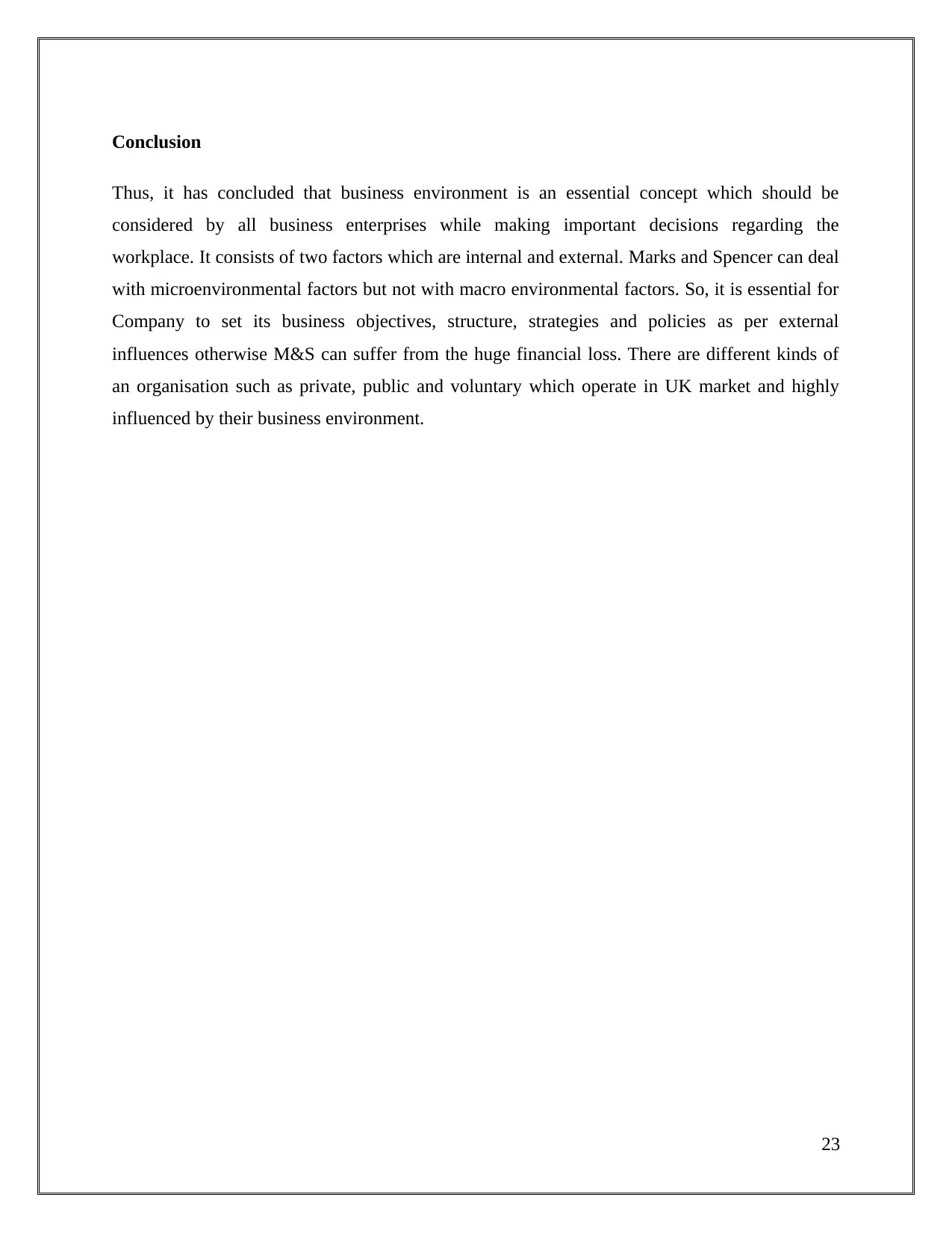
Conclusion
Thus, it has concluded that business environment is an essential concept which should be
considered by all business enterprises while making important decisions regarding the
workplace. It consists of two factors which are internal and external. Marks and Spencer can deal
with microenvironmental factors but not with macro environmental factors. So, it is essential for
Company to set its business objectives, structure, strategies and policies as per external
influences otherwise M&S can suffer from the huge financial loss. There are different kinds of
an organisation such as private, public and voluntary which operate in UK market and highly
influenced by their business environment.
23
Thus, it has concluded that business environment is an essential concept which should be
considered by all business enterprises while making important decisions regarding the
workplace. It consists of two factors which are internal and external. Marks and Spencer can deal
with microenvironmental factors but not with macro environmental factors. So, it is essential for
Company to set its business objectives, structure, strategies and policies as per external
influences otherwise M&S can suffer from the huge financial loss. There are different kinds of
an organisation such as private, public and voluntary which operate in UK market and highly
influenced by their business environment.
23

References
Bohatala, 2017. Macro Environmental Factors For Going Global Market. [Online] Bohatala.
Available at: https://bohatala.com/macro-environmental-factors-for-going-global-market/.
[Accessed: 5 February 2018].
Canvanizer, 2017. SWOT analysis. [Online] Canvanizer. Available at:
https://canvanizer.com/new/swot-canvas. [Accessed: 5 February 2018].
Dhanesh, G.S., 2014. CSR as organization–employee relationship management strategy: A case
study of socially responsible information technology companies in India. Management
Communication Quarterly, vol. 28(1), pp.130-149.
Enalls, T., 2017. How to Capitalize Early on Emerging Trends. SWOT and PESTLE analysis.
Foss, L., Woll, K. and Moilanen, M., 2013. Creativity and implementations of new ideas: do
organisational structure, work environment and gender matter?. International Journal of Gender
and Entrepreneurship, vol. 5(3), pp.298-322.
Green, F., 2012. Employee involvement, technology and evolution in job skills: A task-based
analysis. ILR Review, vol. 65(1), pp.36-67.
Harris, R., 2013. The Private Origins of the Private Company: Britain 1862–1907. Oxford
Journal of Legal Studies, vol. 33(2), pp.339-378.
Padmanand, V., Reddy, M.C., Sathyaprakash, T.L. and Sood, K., 2016. Rise of the Third World:
In the Enabling Policy and Business Environment. Small Enterprises Development, Management
& Extension (Sedme), pp. 41(3).
Shehu, A.M. and Mahmood, R., 2014. Influence of entrepreneurial orientation and business
environment on small and medium firm performance: a pls approach. Advances in Management
and Applied Economics, vol. 4 no 4, pp.101.
24
Bohatala, 2017. Macro Environmental Factors For Going Global Market. [Online] Bohatala.
Available at: https://bohatala.com/macro-environmental-factors-for-going-global-market/.
[Accessed: 5 February 2018].
Canvanizer, 2017. SWOT analysis. [Online] Canvanizer. Available at:
https://canvanizer.com/new/swot-canvas. [Accessed: 5 February 2018].
Dhanesh, G.S., 2014. CSR as organization–employee relationship management strategy: A case
study of socially responsible information technology companies in India. Management
Communication Quarterly, vol. 28(1), pp.130-149.
Enalls, T., 2017. How to Capitalize Early on Emerging Trends. SWOT and PESTLE analysis.
Foss, L., Woll, K. and Moilanen, M., 2013. Creativity and implementations of new ideas: do
organisational structure, work environment and gender matter?. International Journal of Gender
and Entrepreneurship, vol. 5(3), pp.298-322.
Green, F., 2012. Employee involvement, technology and evolution in job skills: A task-based
analysis. ILR Review, vol. 65(1), pp.36-67.
Harris, R., 2013. The Private Origins of the Private Company: Britain 1862–1907. Oxford
Journal of Legal Studies, vol. 33(2), pp.339-378.
Padmanand, V., Reddy, M.C., Sathyaprakash, T.L. and Sood, K., 2016. Rise of the Third World:
In the Enabling Policy and Business Environment. Small Enterprises Development, Management
& Extension (Sedme), pp. 41(3).
Shehu, A.M. and Mahmood, R., 2014. Influence of entrepreneurial orientation and business
environment on small and medium firm performance: a pls approach. Advances in Management
and Applied Economics, vol. 4 no 4, pp.101.
24
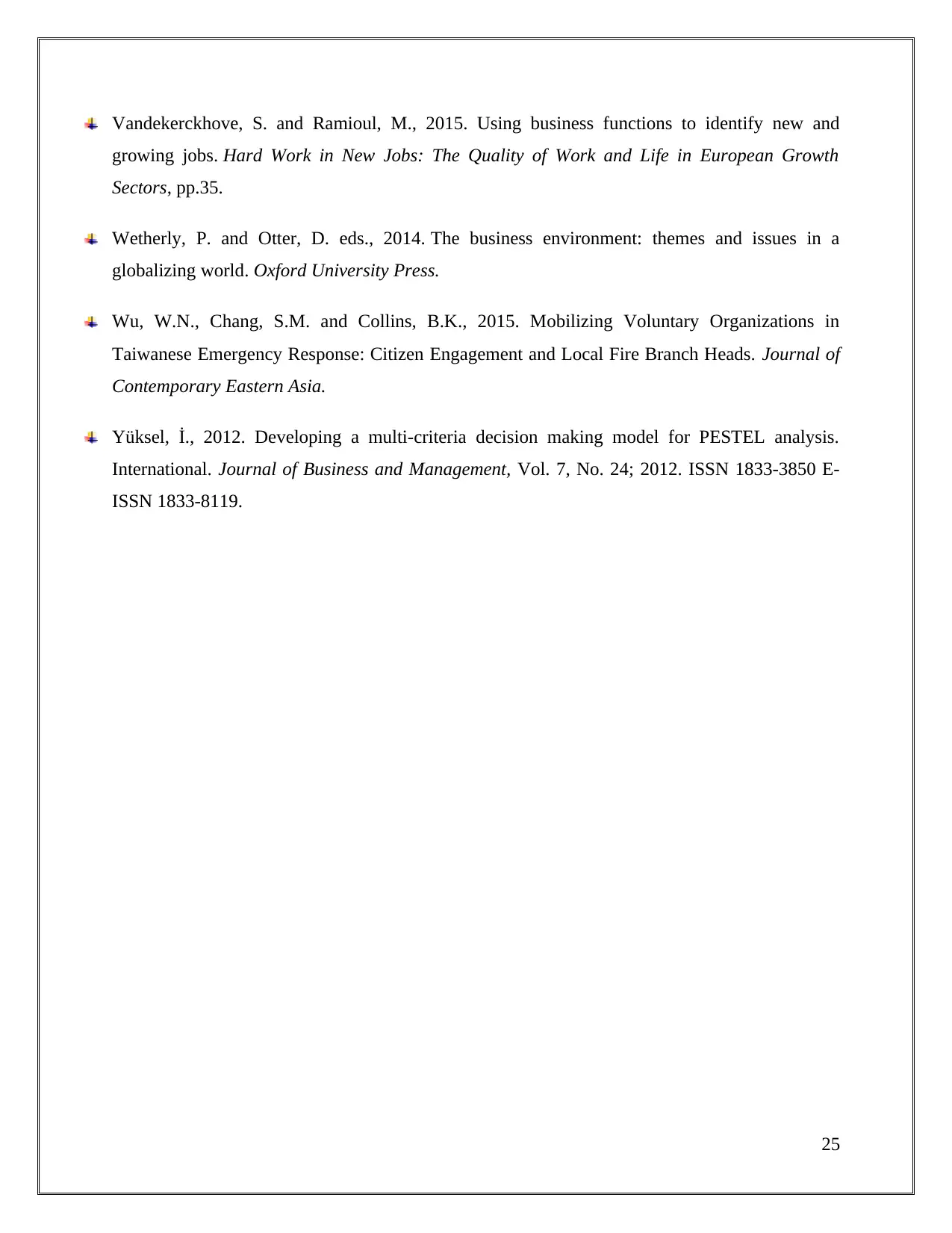
Vandekerckhove, S. and Ramioul, M., 2015. Using business functions to identify new and
growing jobs. Hard Work in New Jobs: The Quality of Work and Life in European Growth
Sectors, pp.35.
Wetherly, P. and Otter, D. eds., 2014. The business environment: themes and issues in a
globalizing world. Oxford University Press.
Wu, W.N., Chang, S.M. and Collins, B.K., 2015. Mobilizing Voluntary Organizations in
Taiwanese Emergency Response: Citizen Engagement and Local Fire Branch Heads. Journal of
Contemporary Eastern Asia.
Yüksel, İ., 2012. Developing a multi-criteria decision making model for PESTEL analysis.
International. Journal of Business and Management, Vol. 7, No. 24; 2012. ISSN 1833-3850 E-
ISSN 1833-8119.
25
growing jobs. Hard Work in New Jobs: The Quality of Work and Life in European Growth
Sectors, pp.35.
Wetherly, P. and Otter, D. eds., 2014. The business environment: themes and issues in a
globalizing world. Oxford University Press.
Wu, W.N., Chang, S.M. and Collins, B.K., 2015. Mobilizing Voluntary Organizations in
Taiwanese Emergency Response: Citizen Engagement and Local Fire Branch Heads. Journal of
Contemporary Eastern Asia.
Yüksel, İ., 2012. Developing a multi-criteria decision making model for PESTEL analysis.
International. Journal of Business and Management, Vol. 7, No. 24; 2012. ISSN 1833-3850 E-
ISSN 1833-8119.
25
1 out of 25
Related Documents
Your All-in-One AI-Powered Toolkit for Academic Success.
+13062052269
info@desklib.com
Available 24*7 on WhatsApp / Email
![[object Object]](/_next/static/media/star-bottom.7253800d.svg)
Unlock your academic potential
© 2024 | Zucol Services PVT LTD | All rights reserved.





